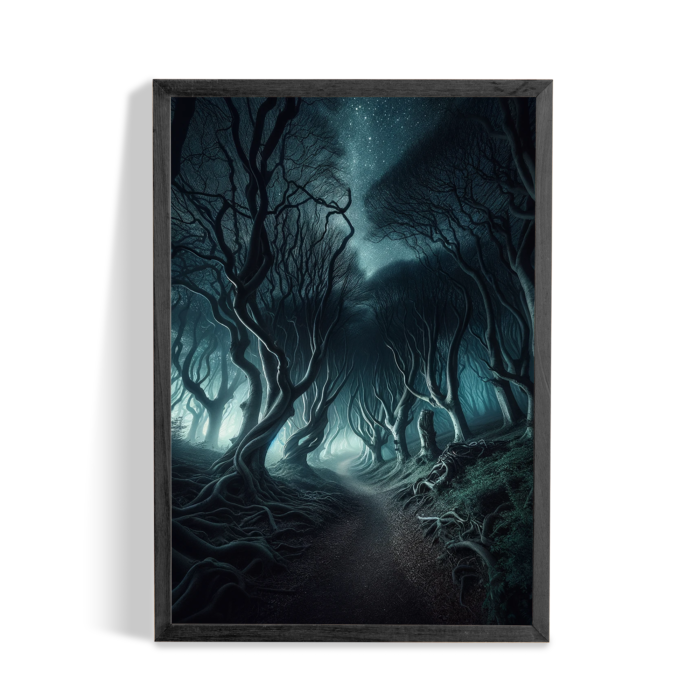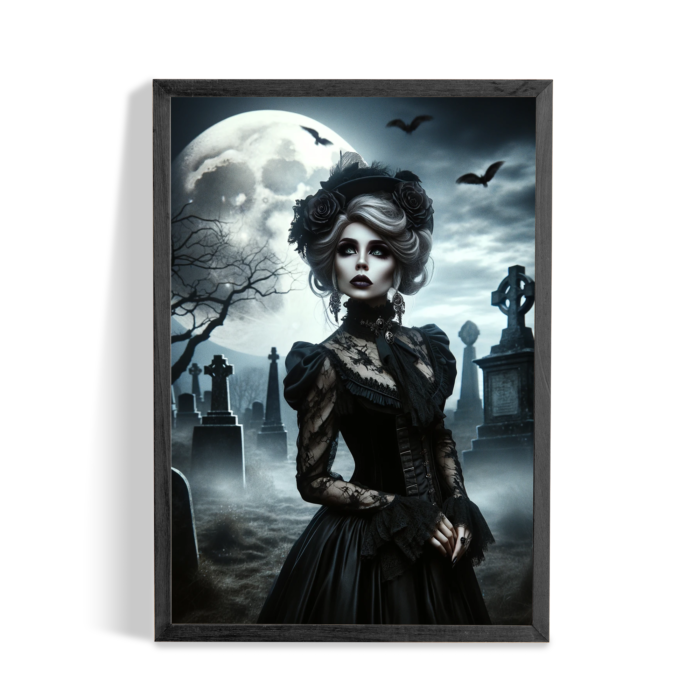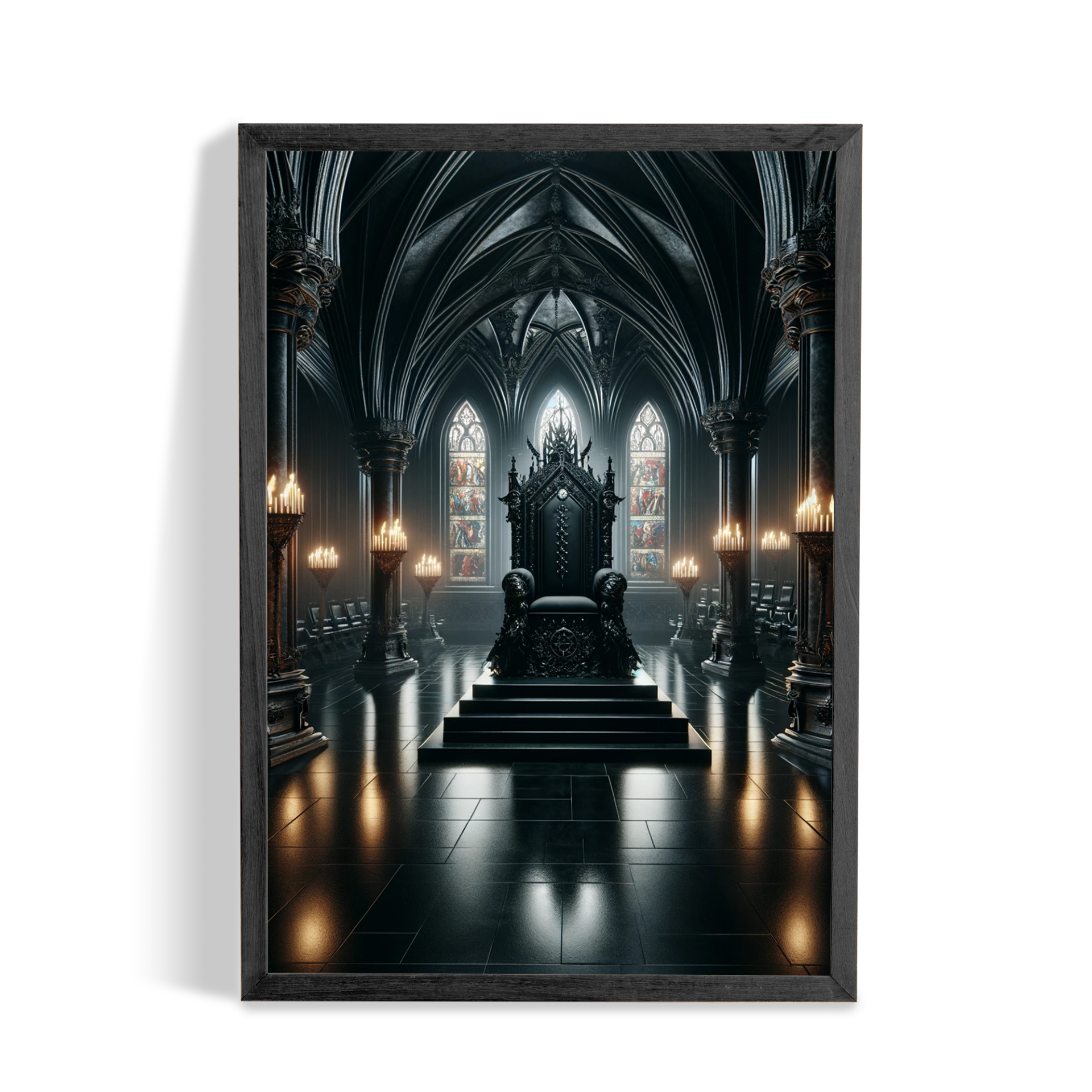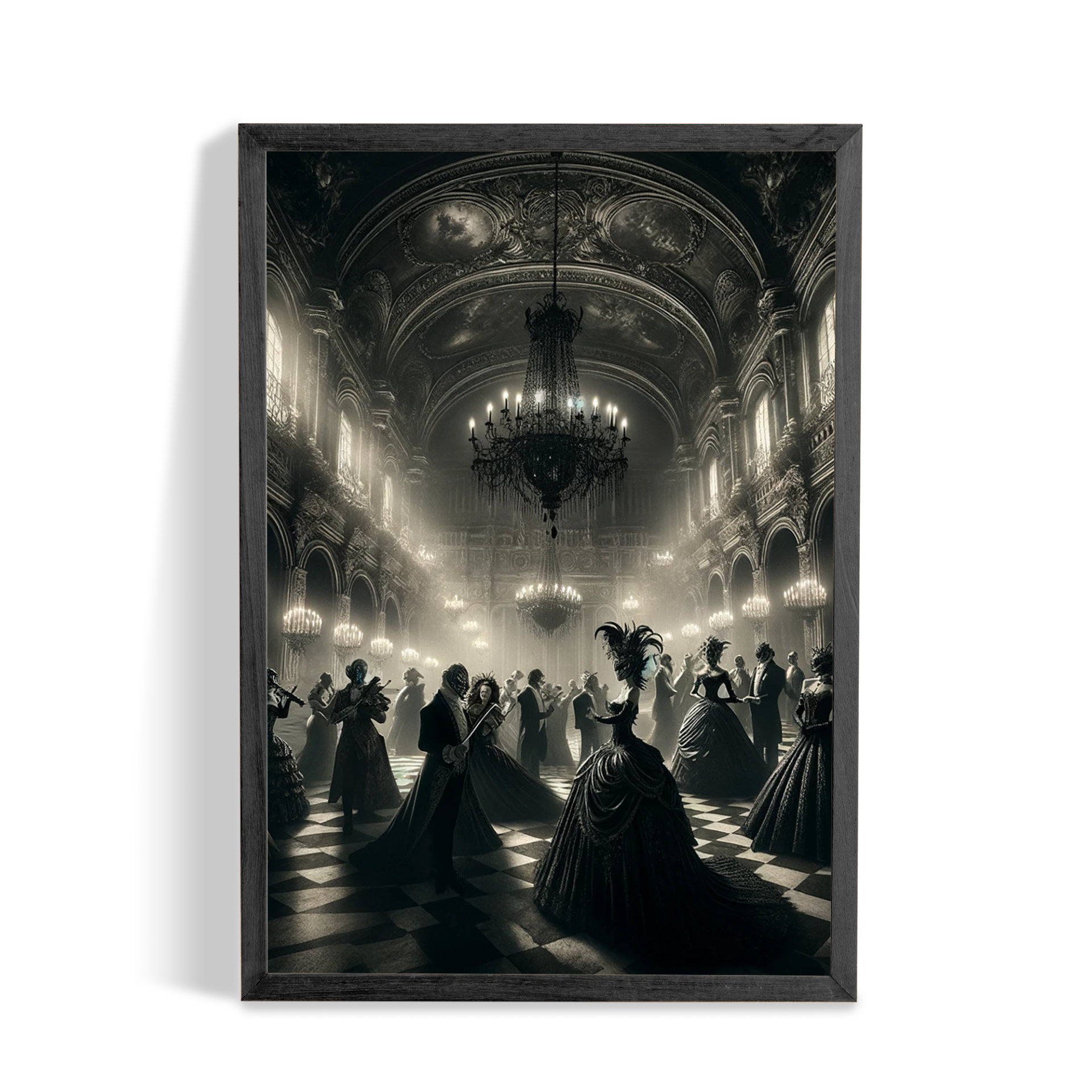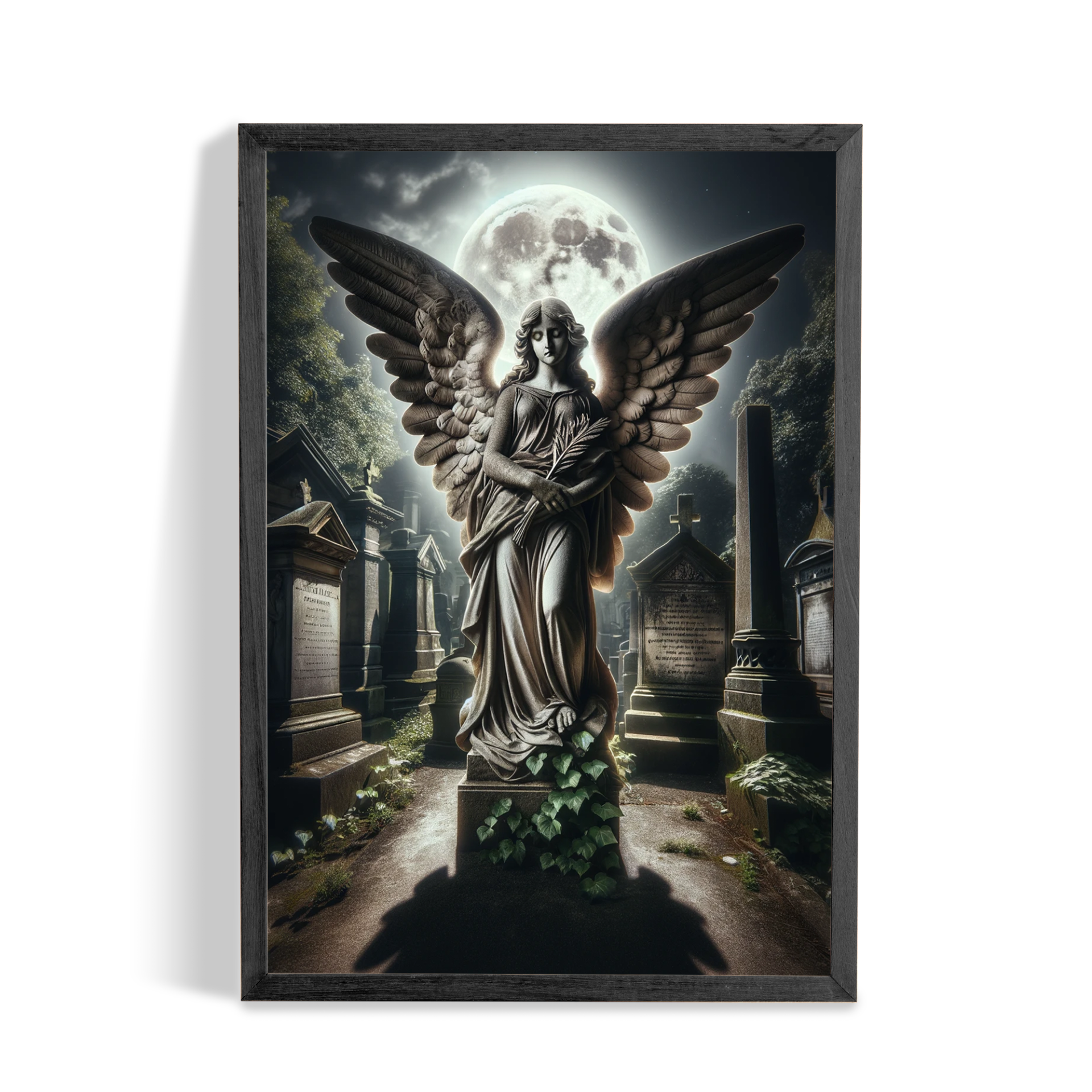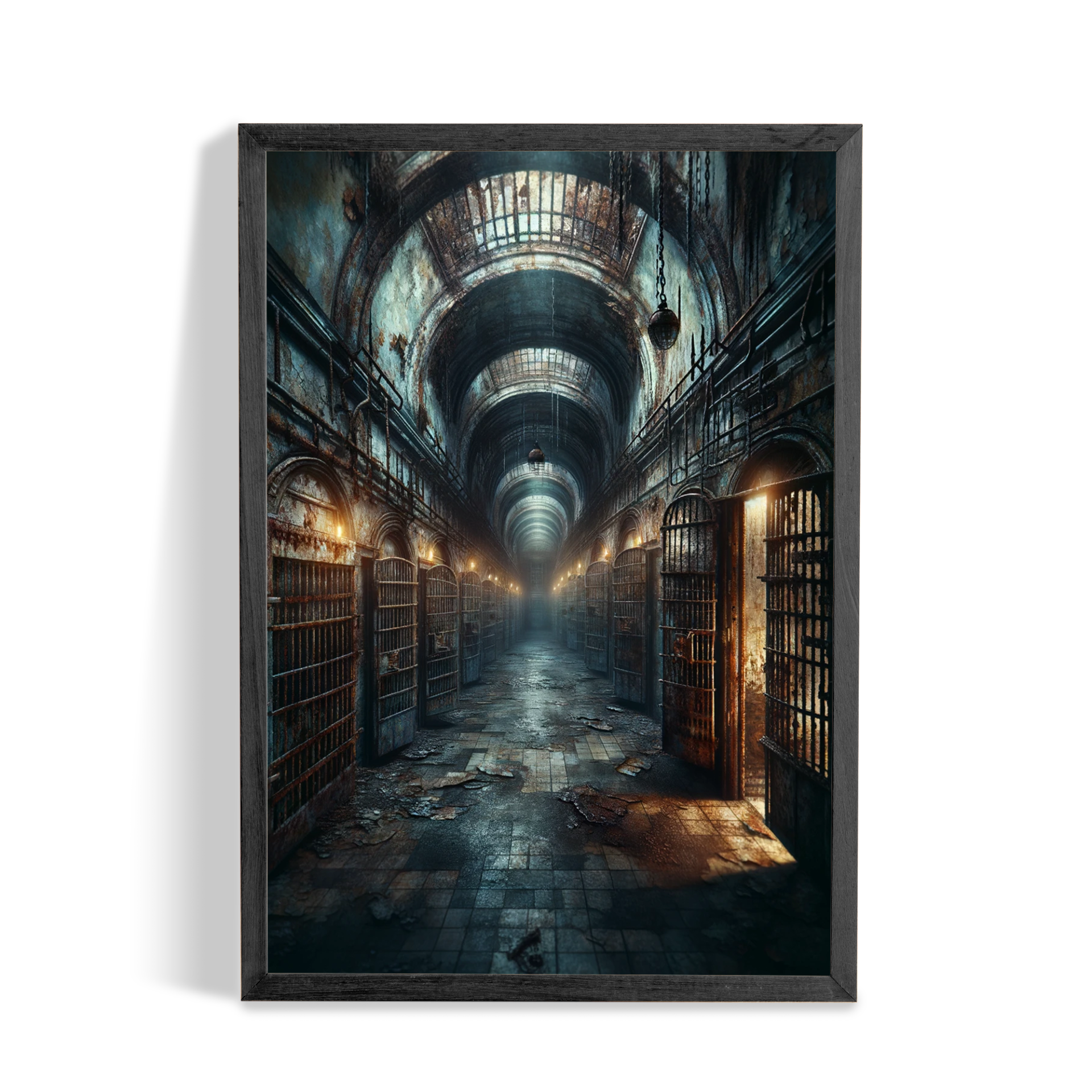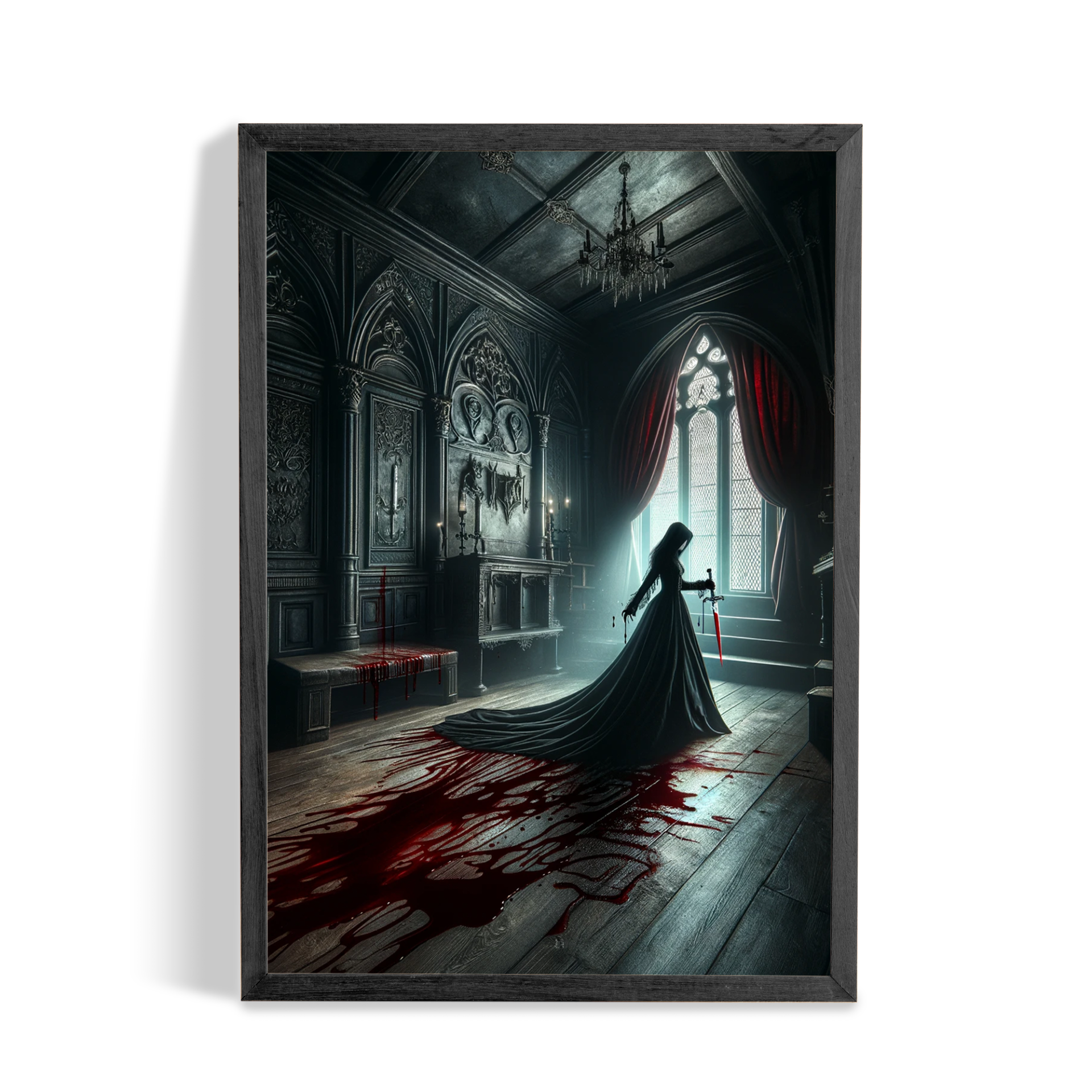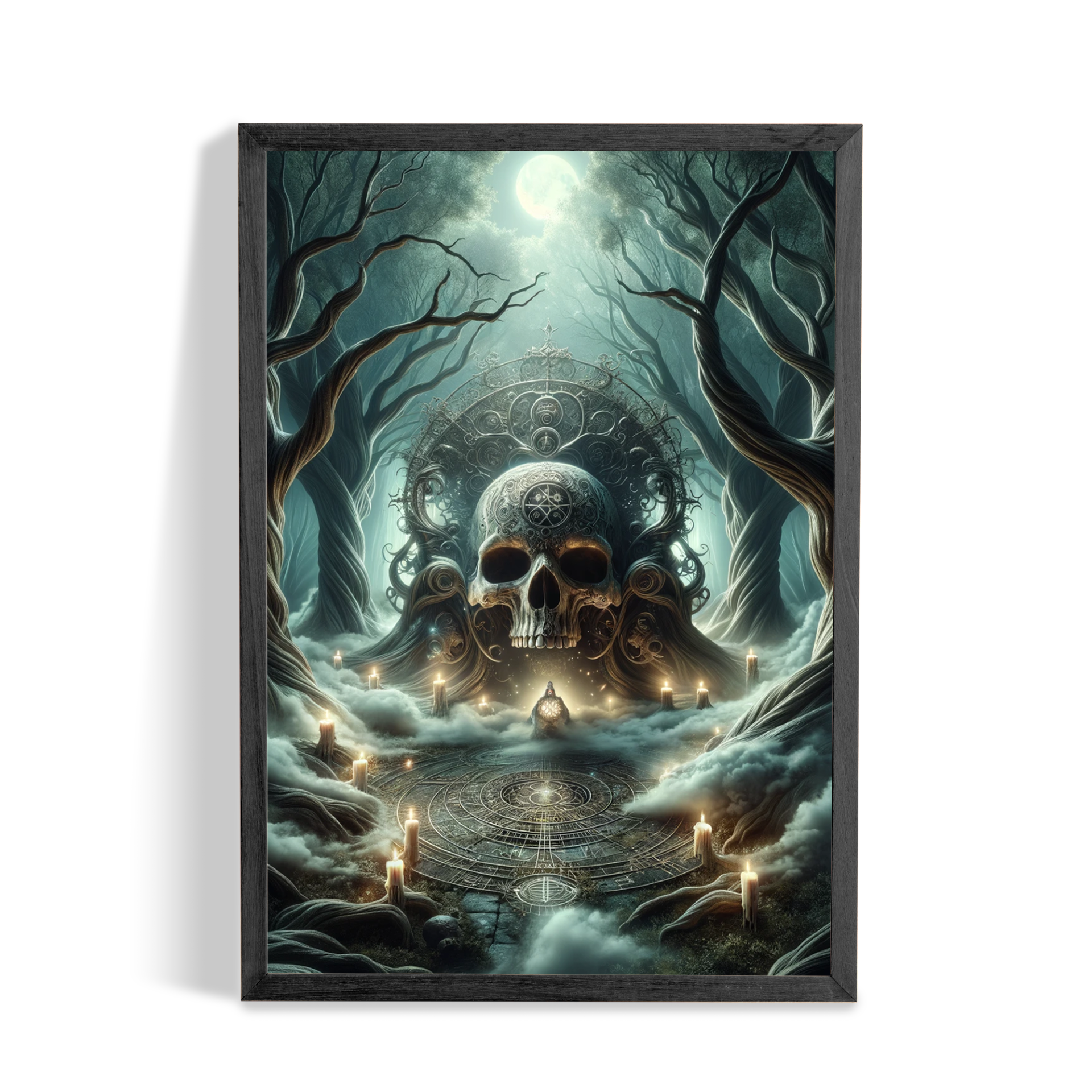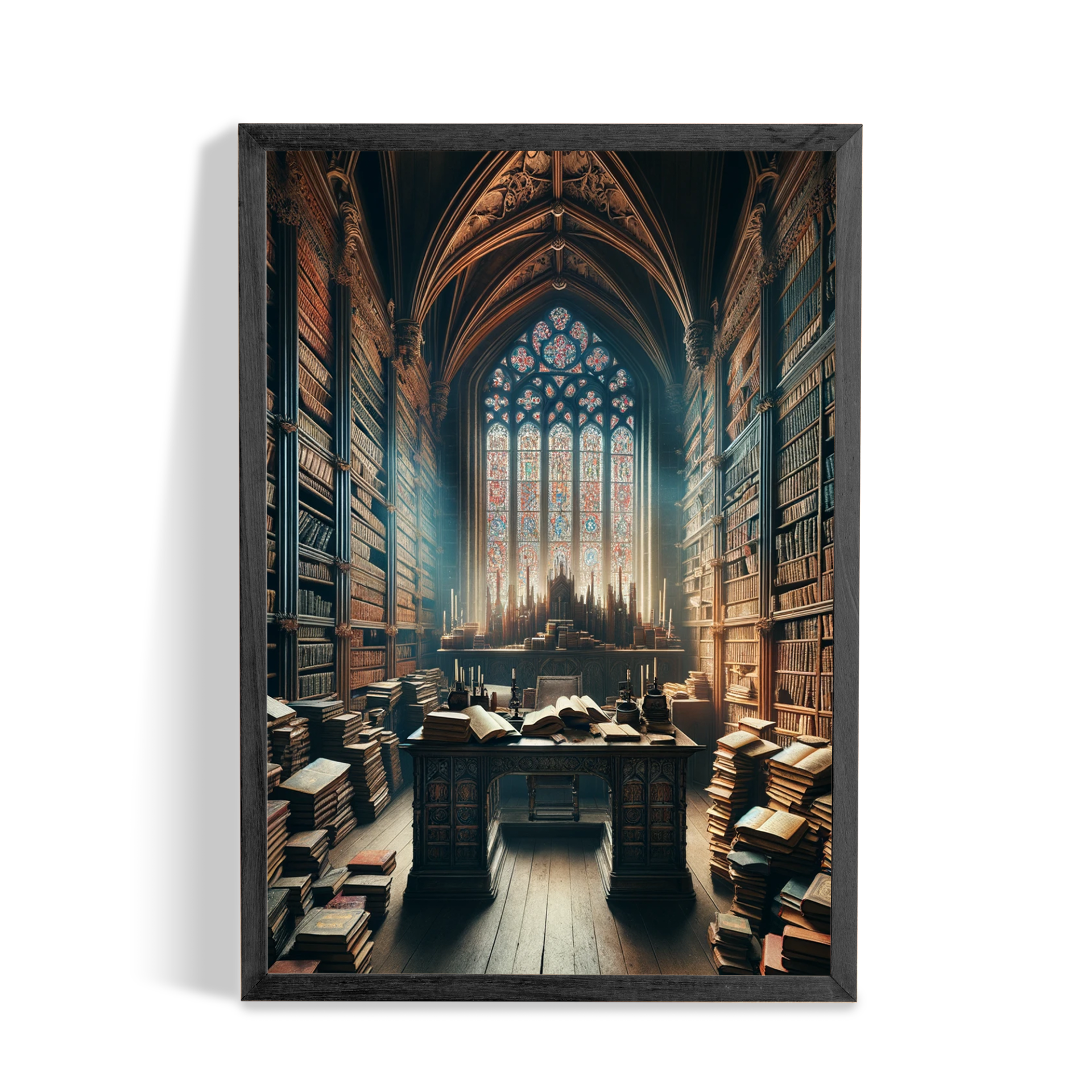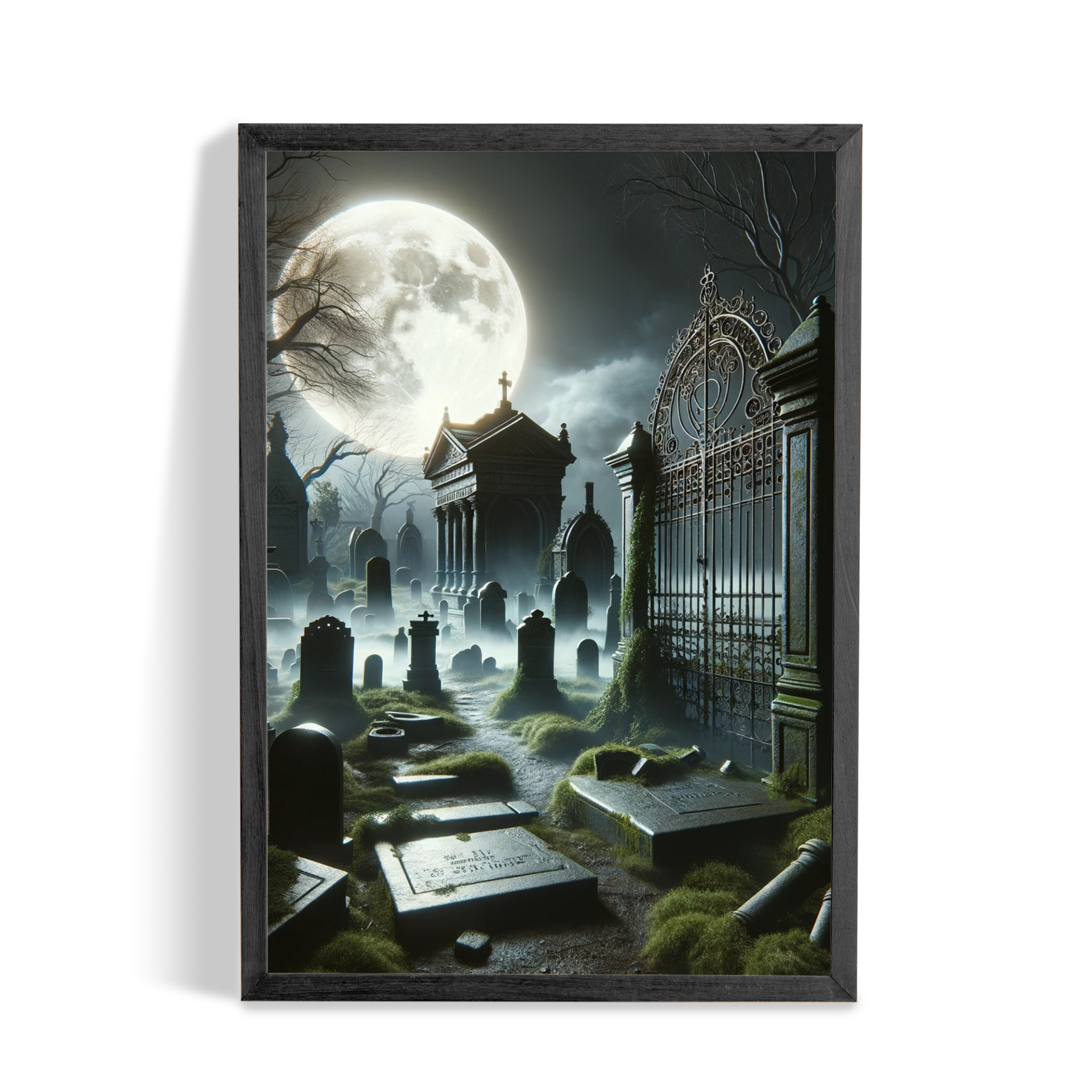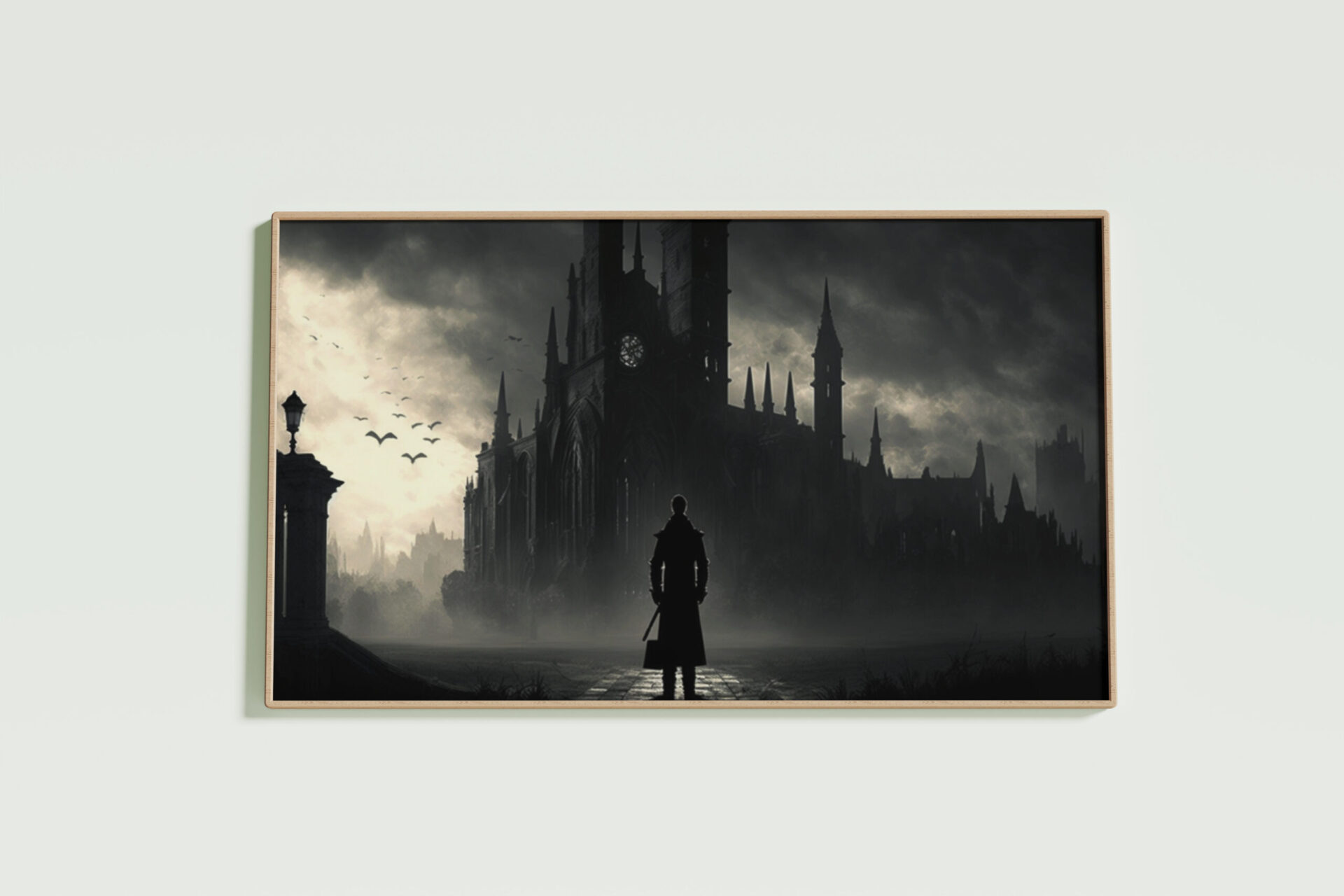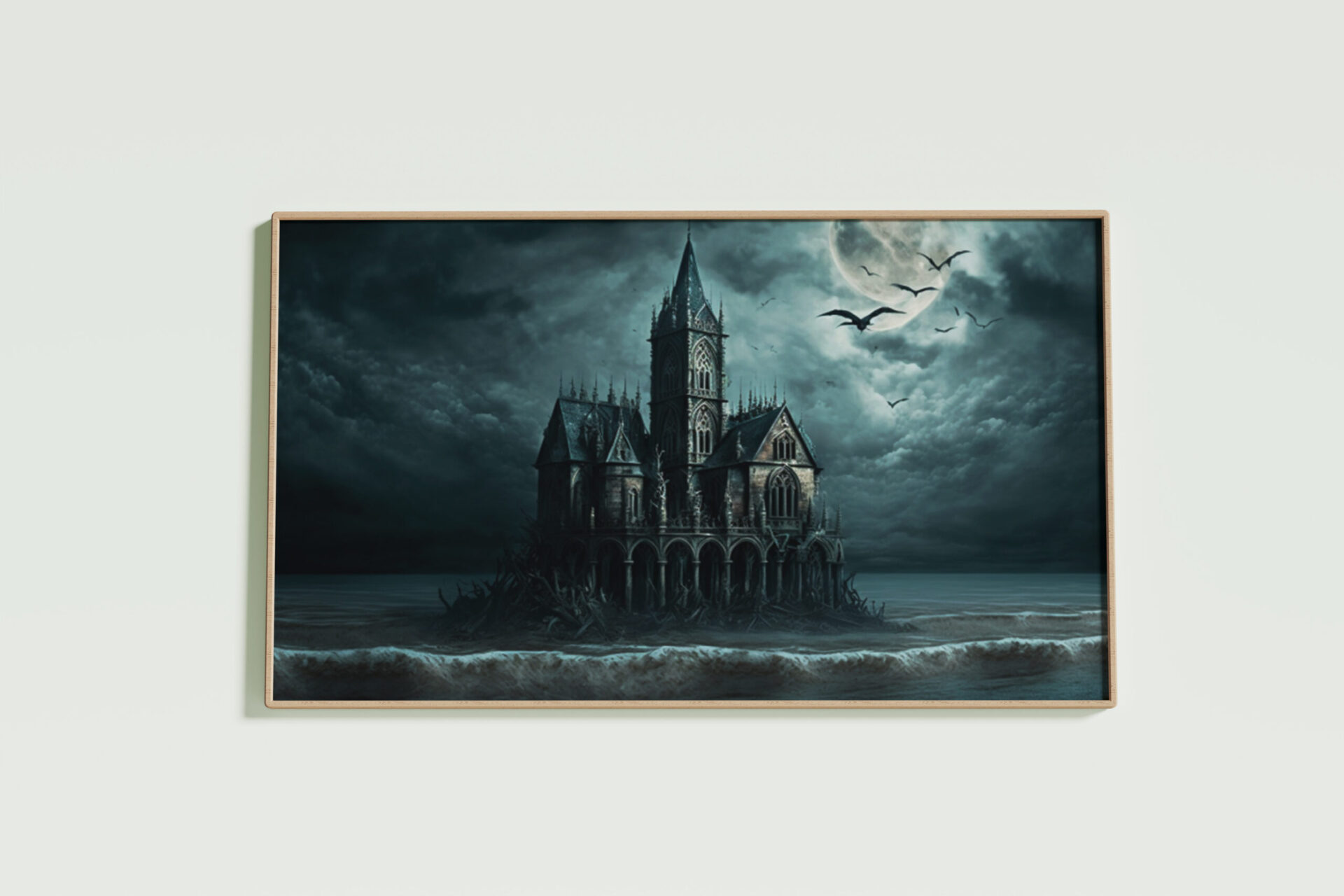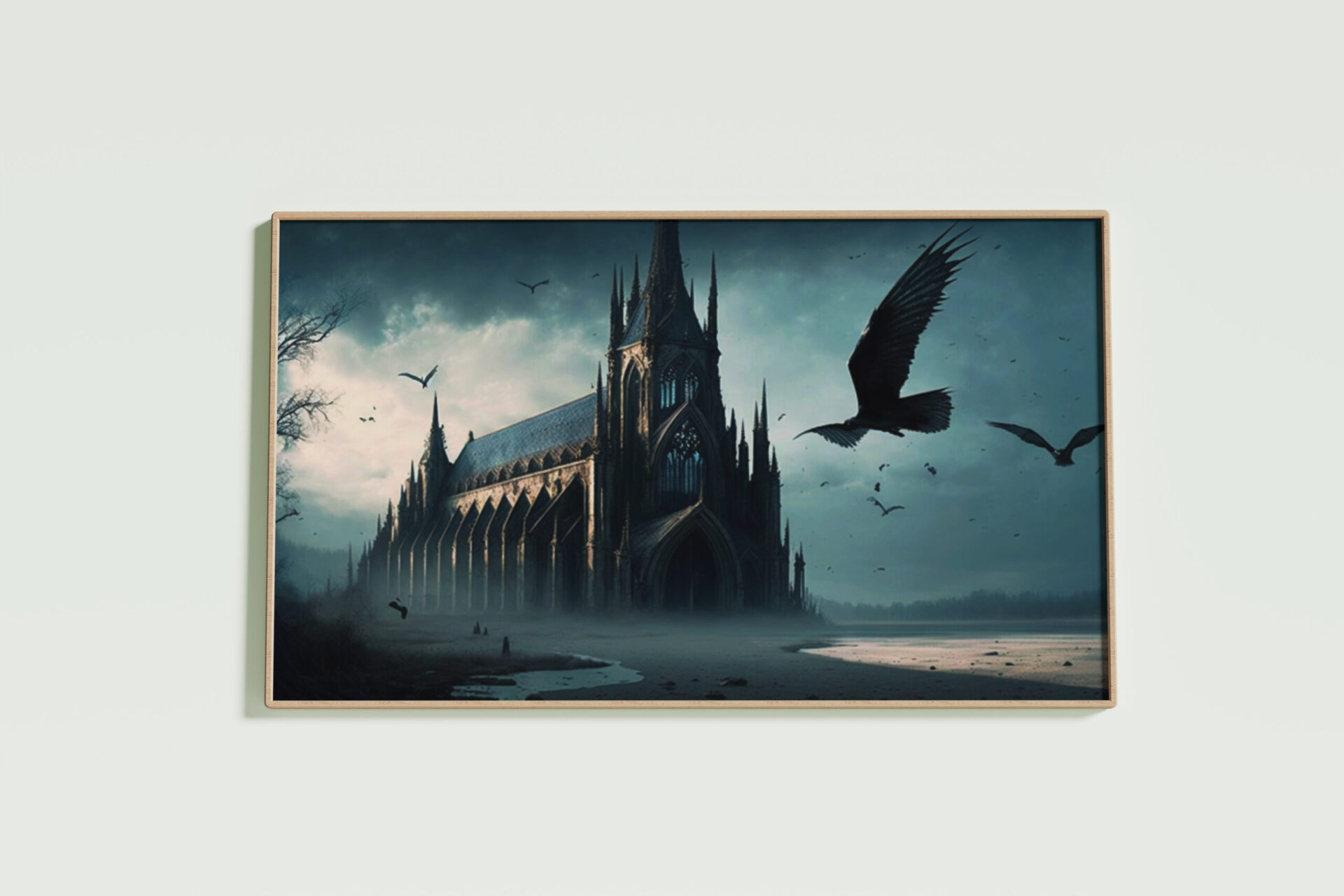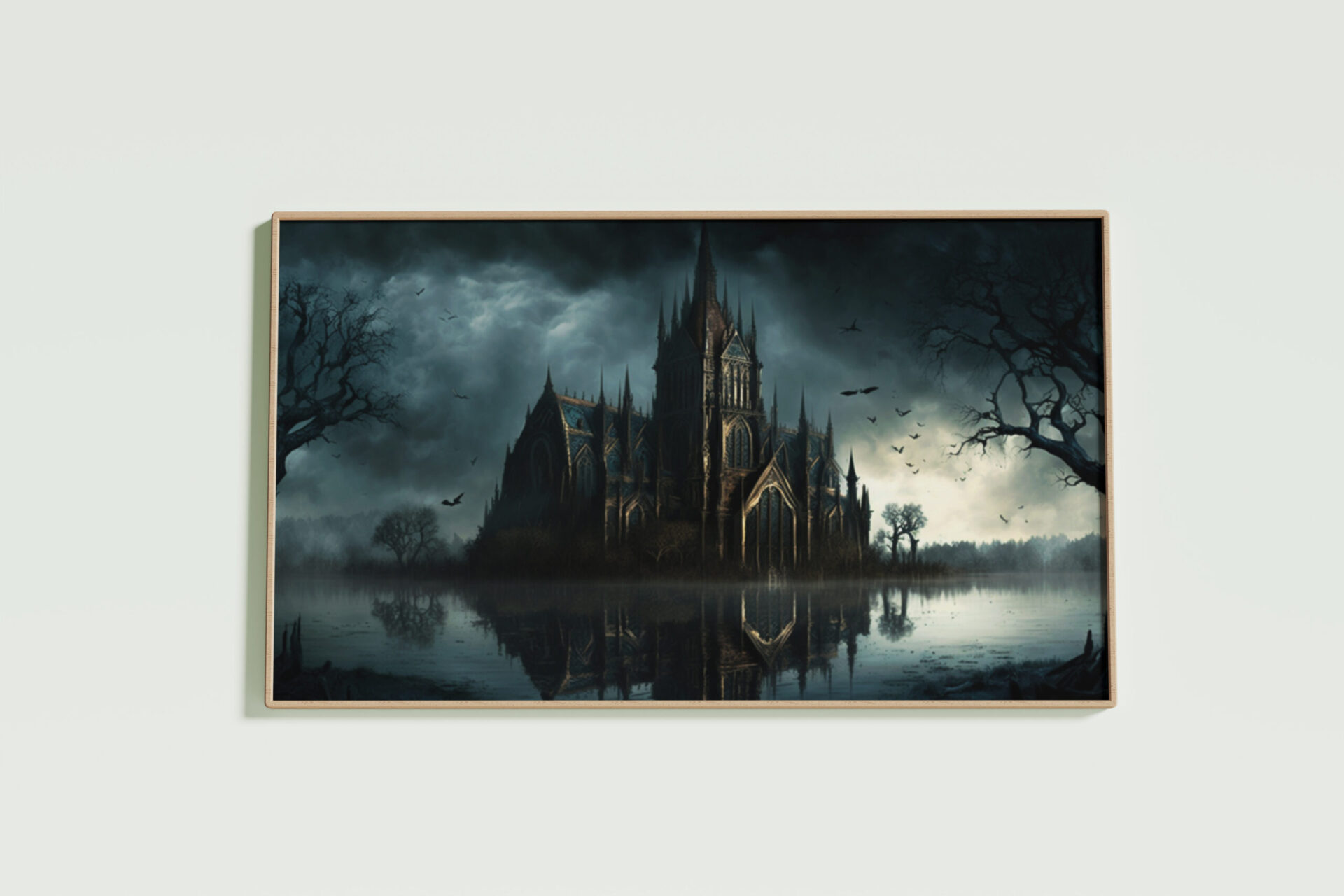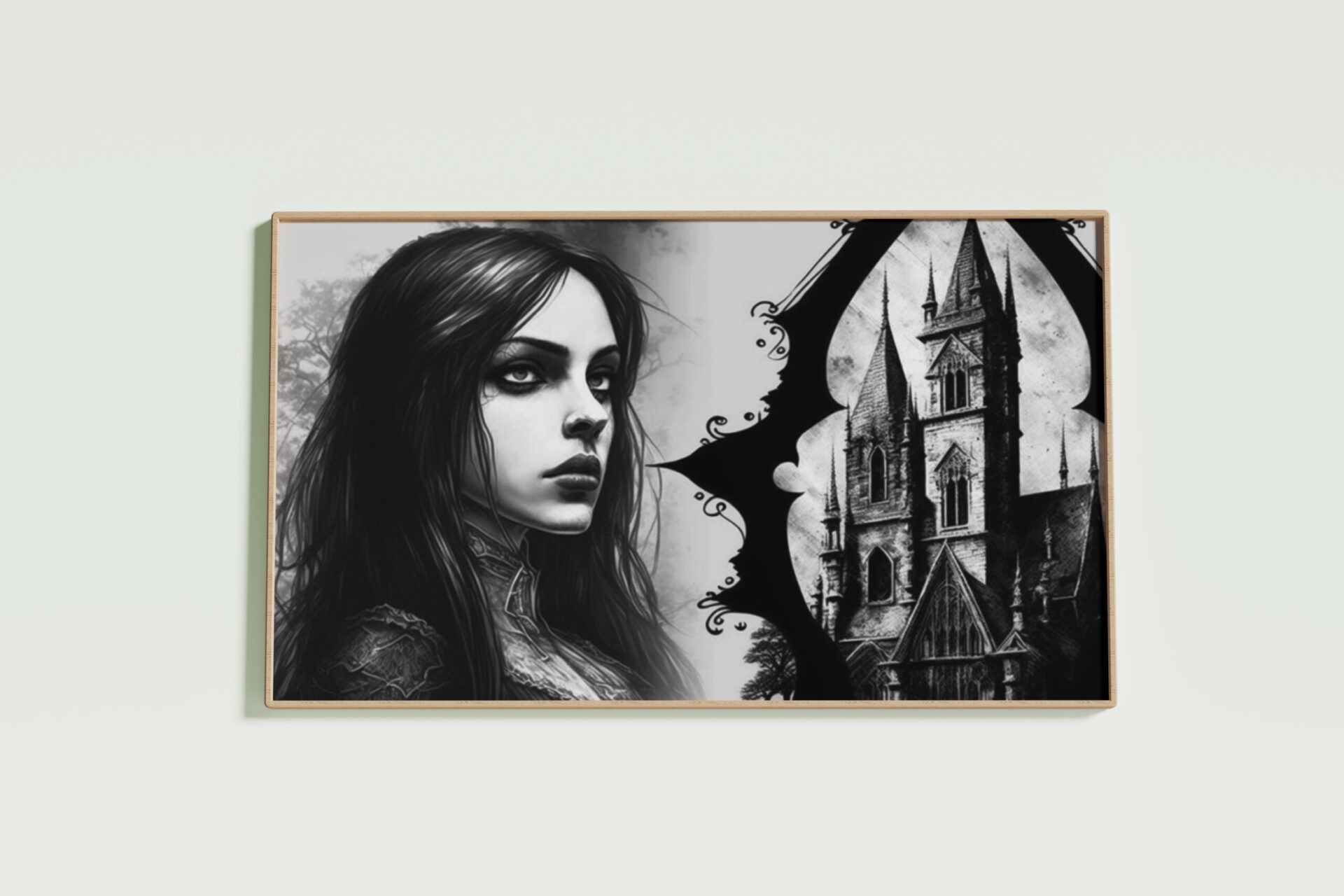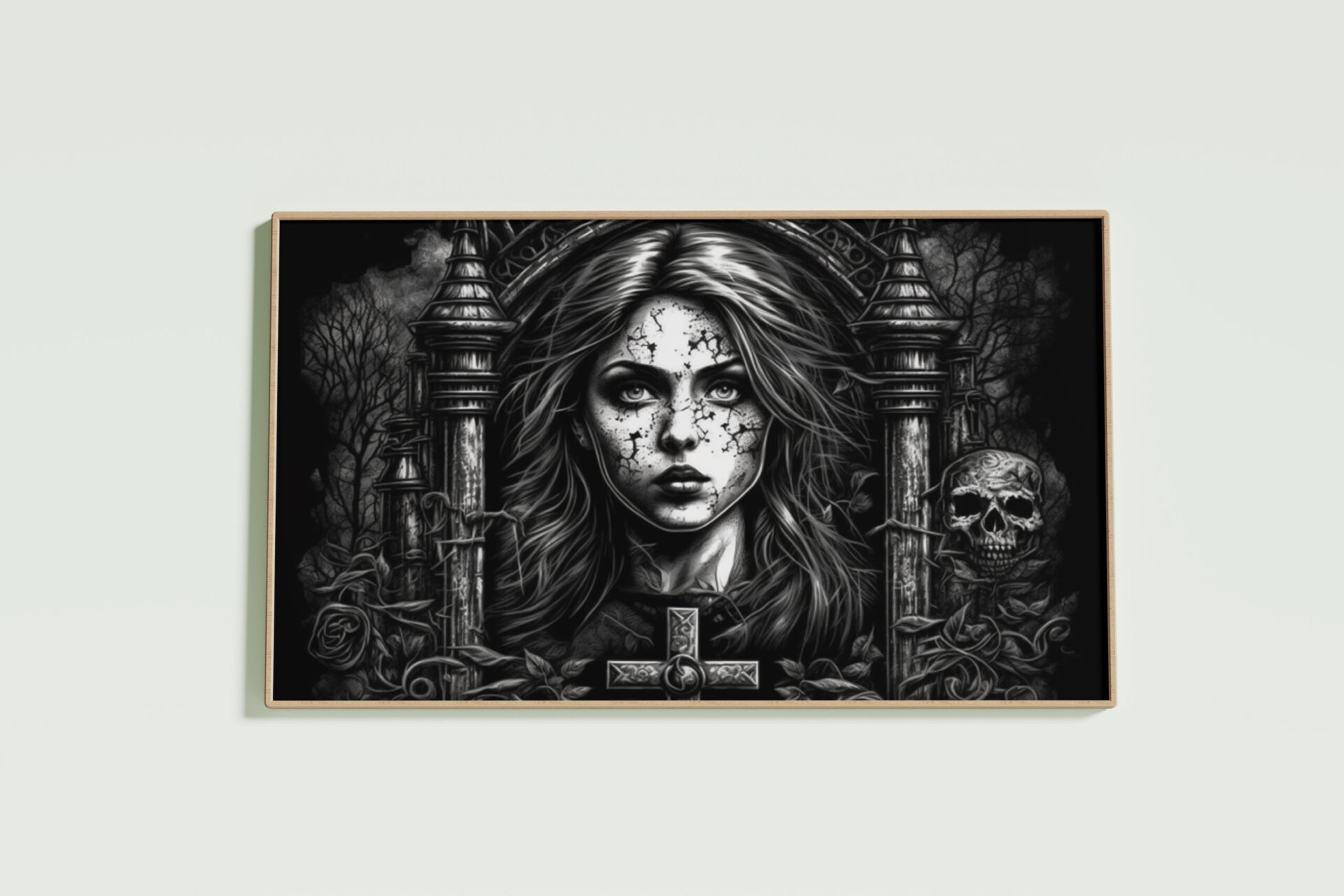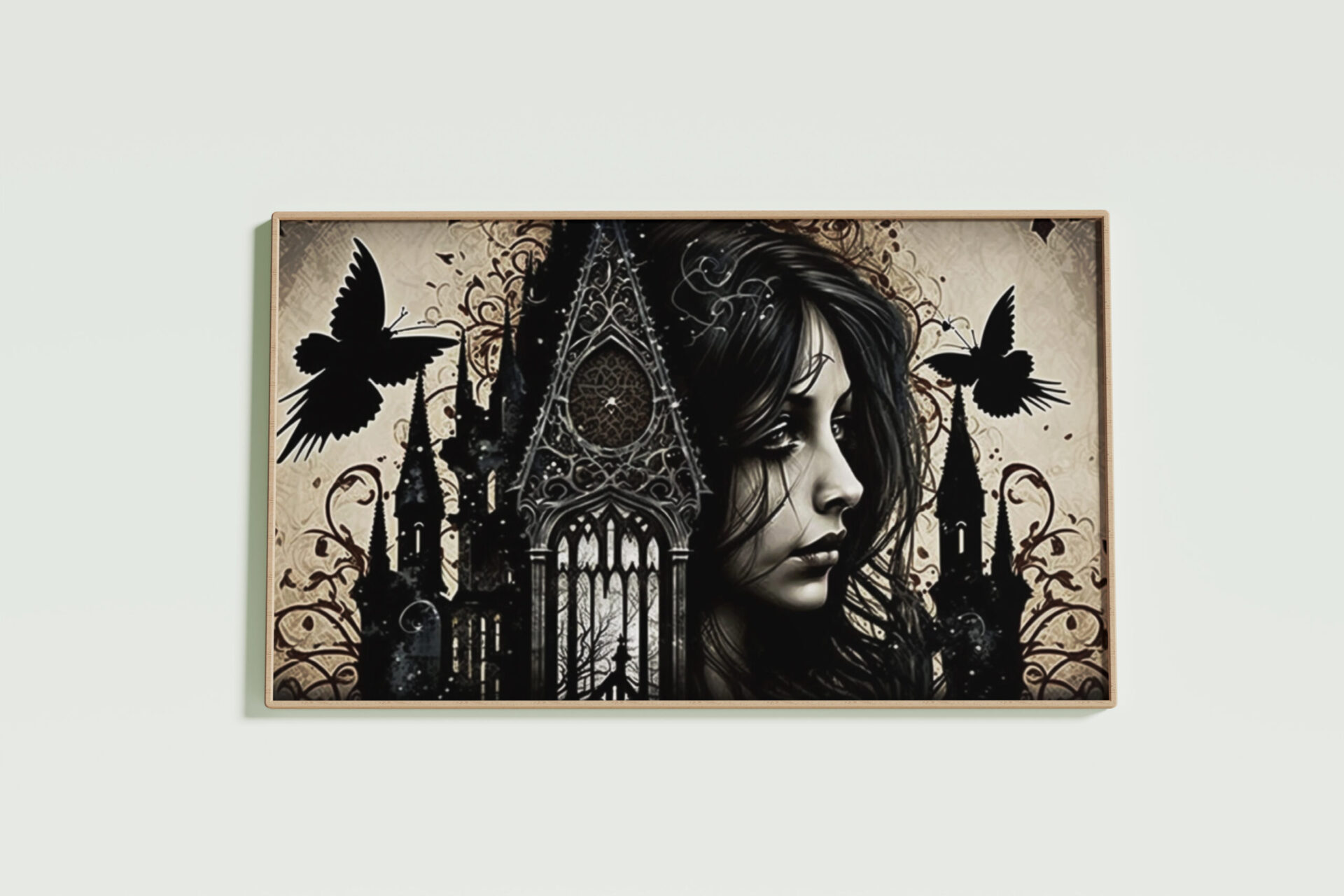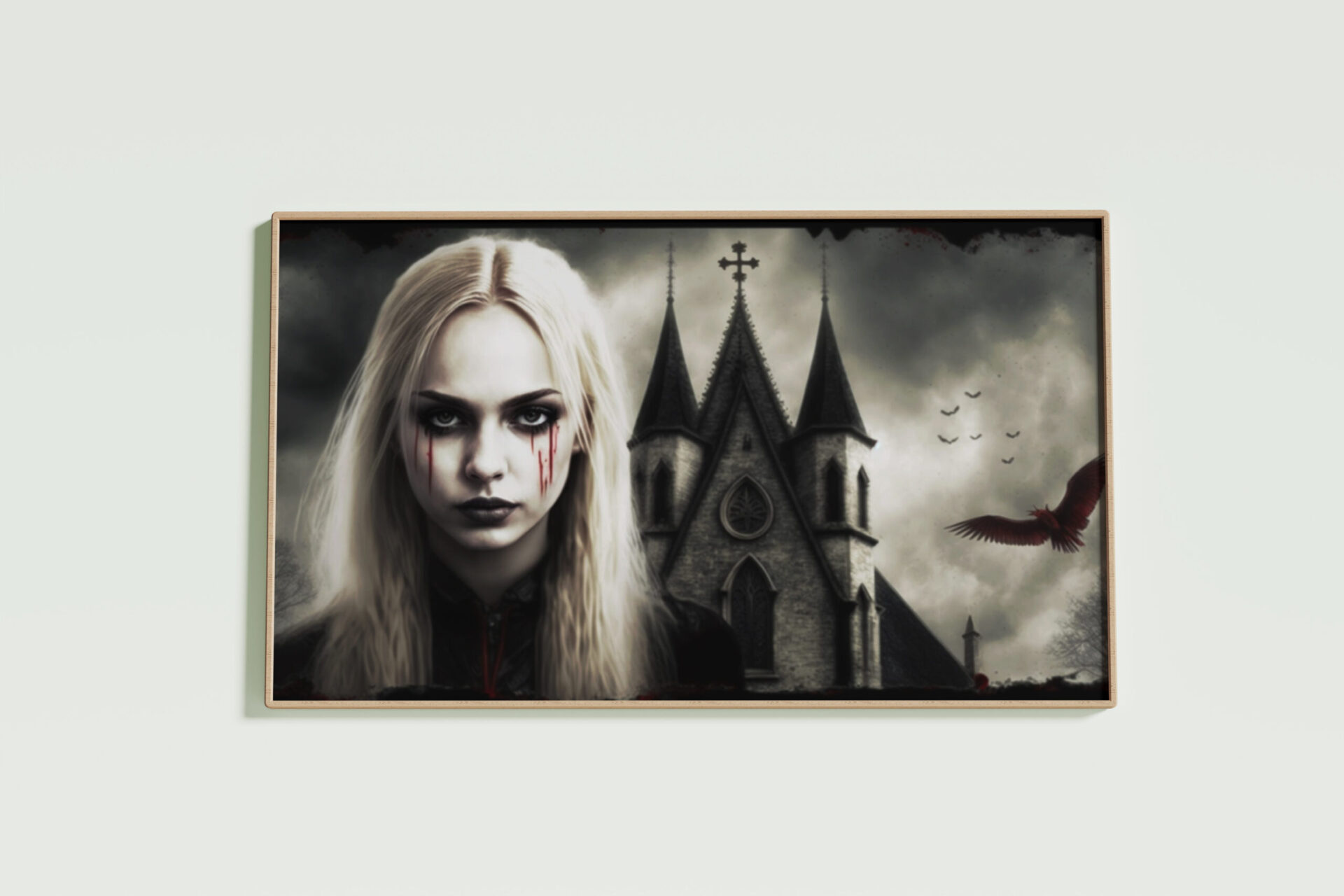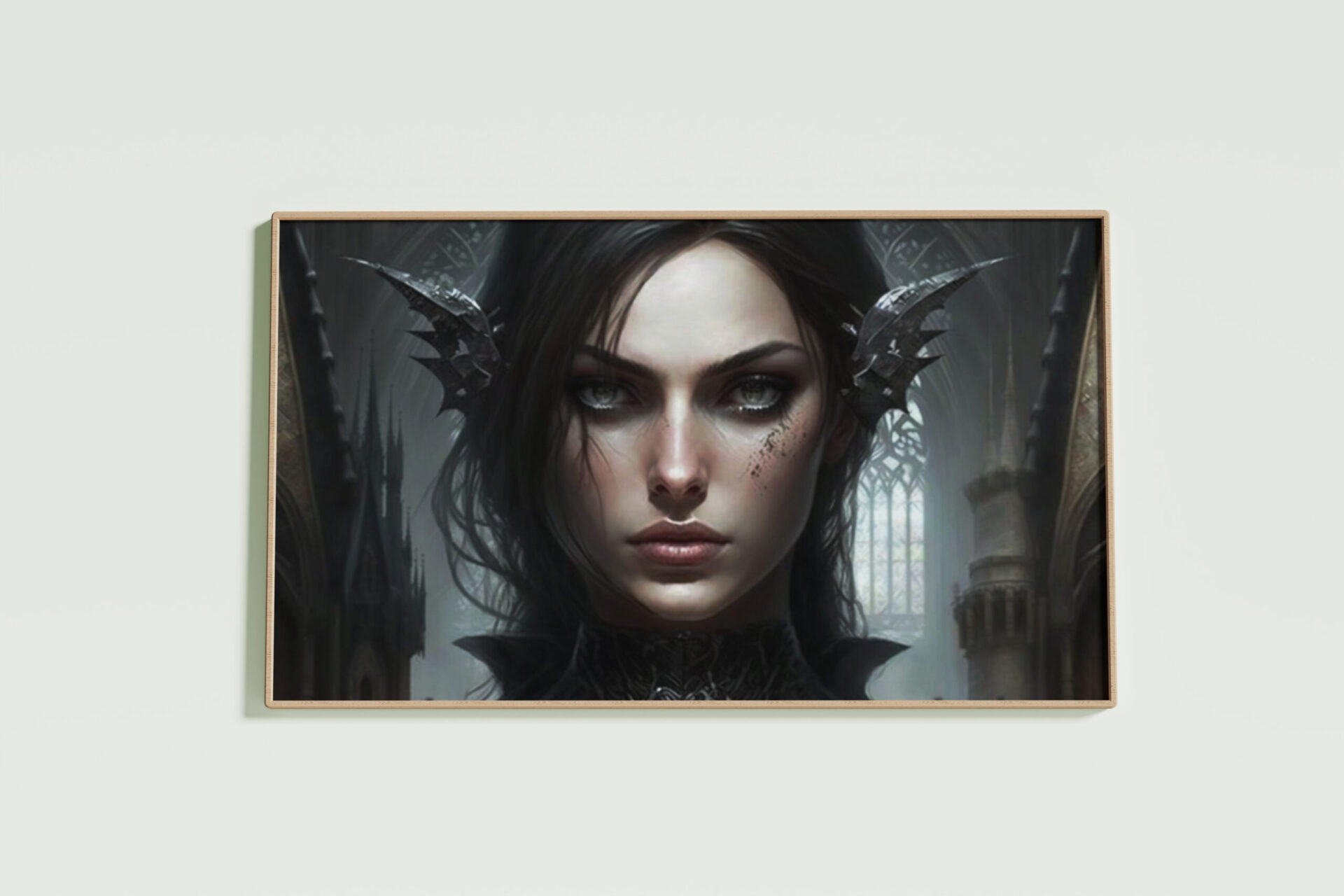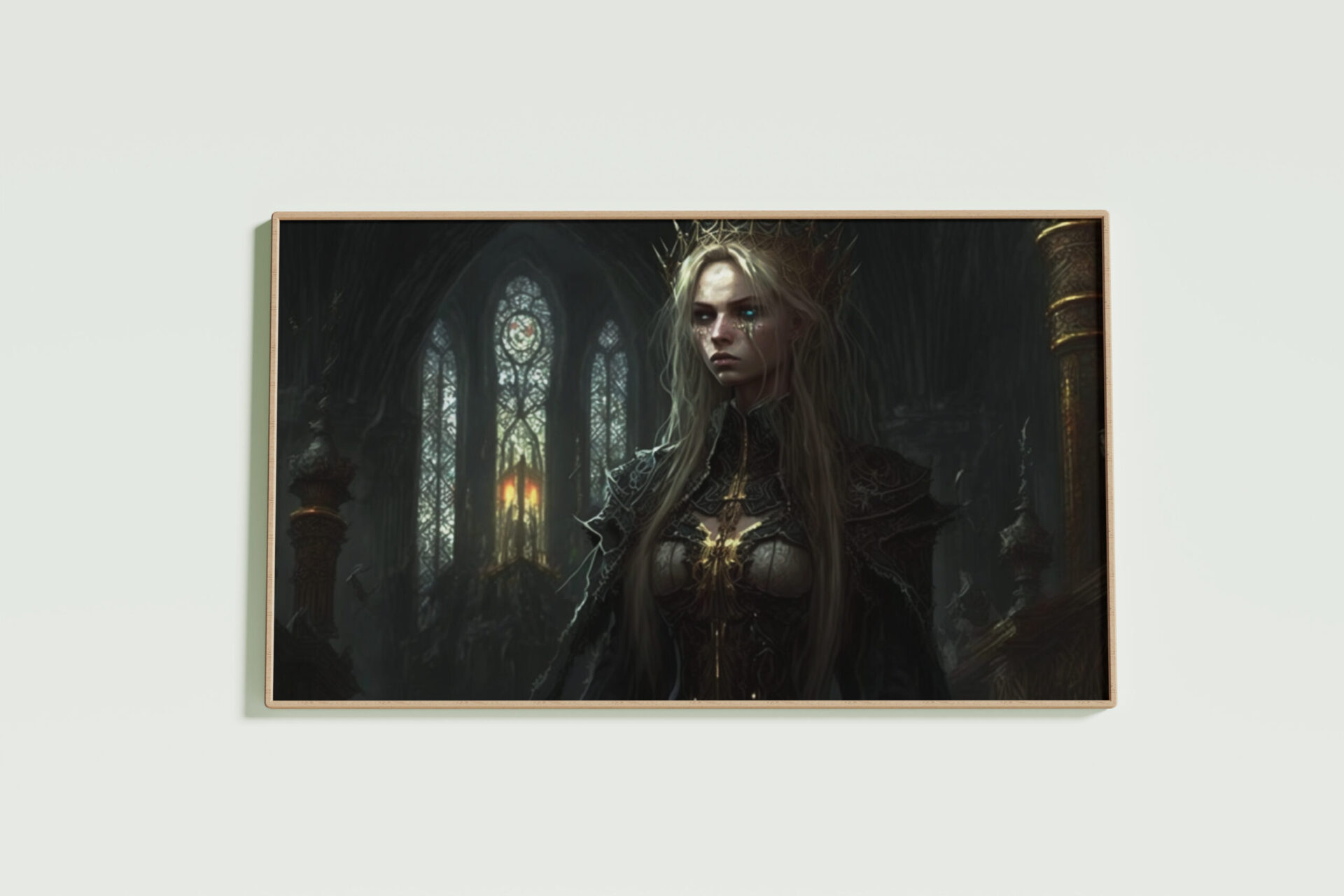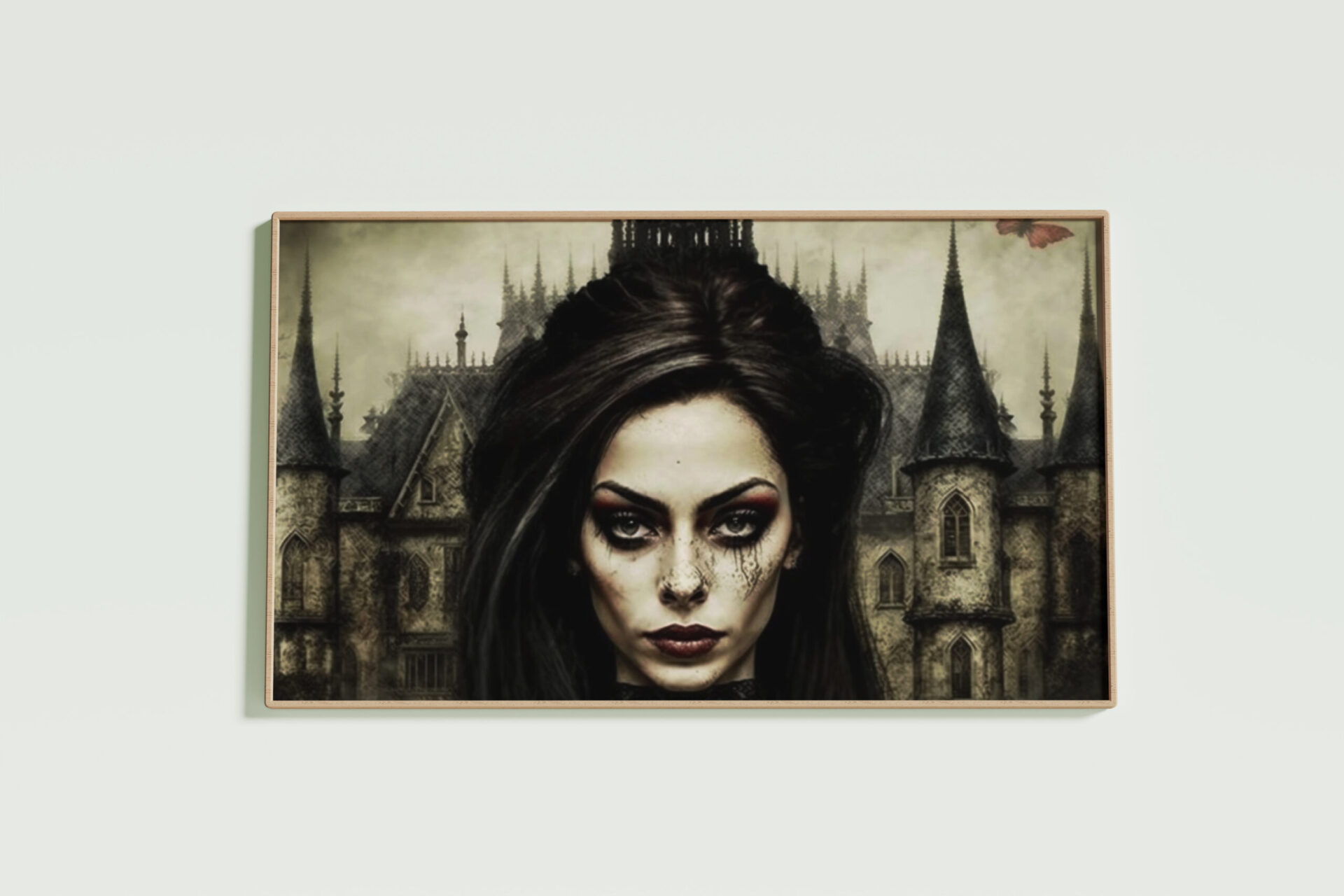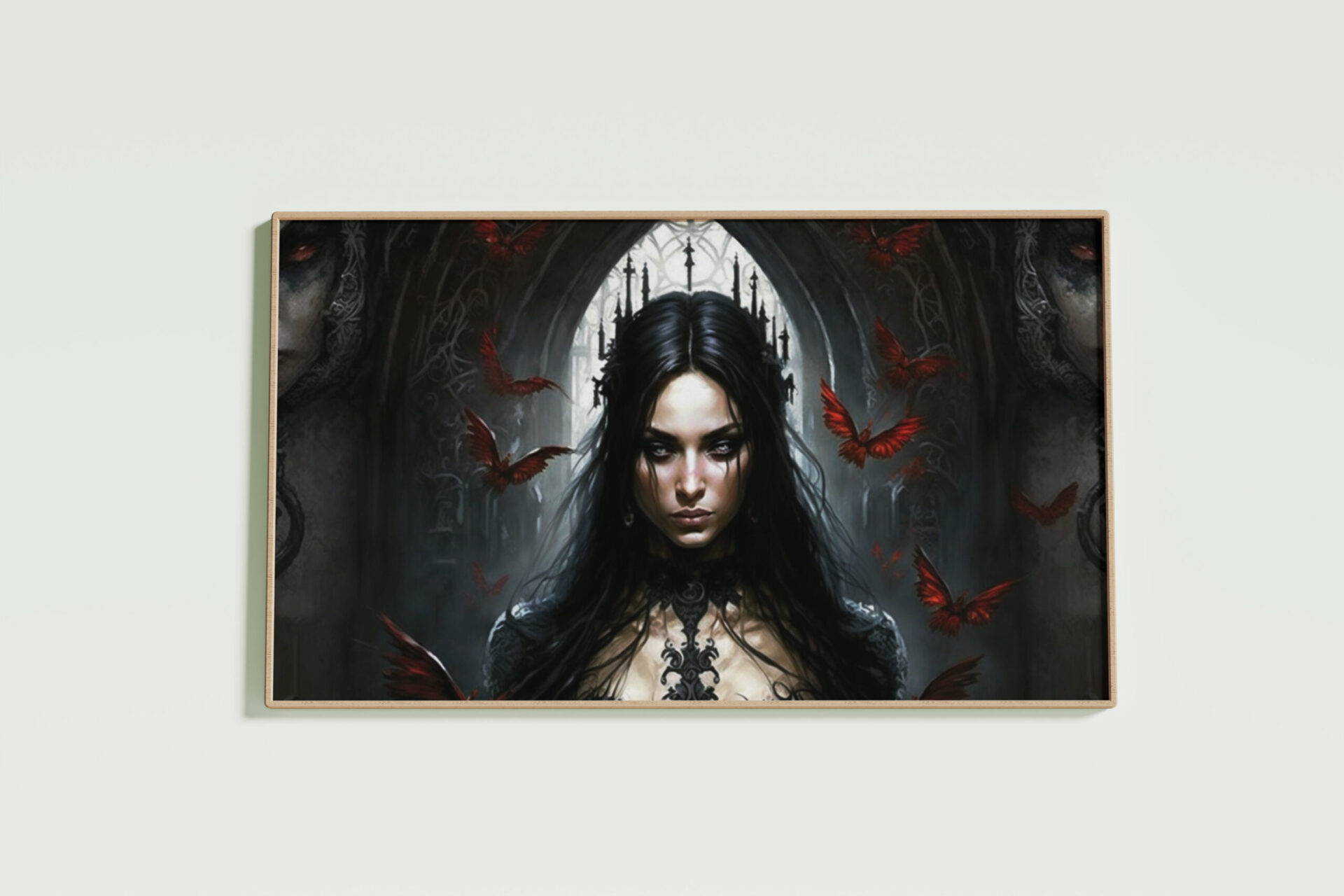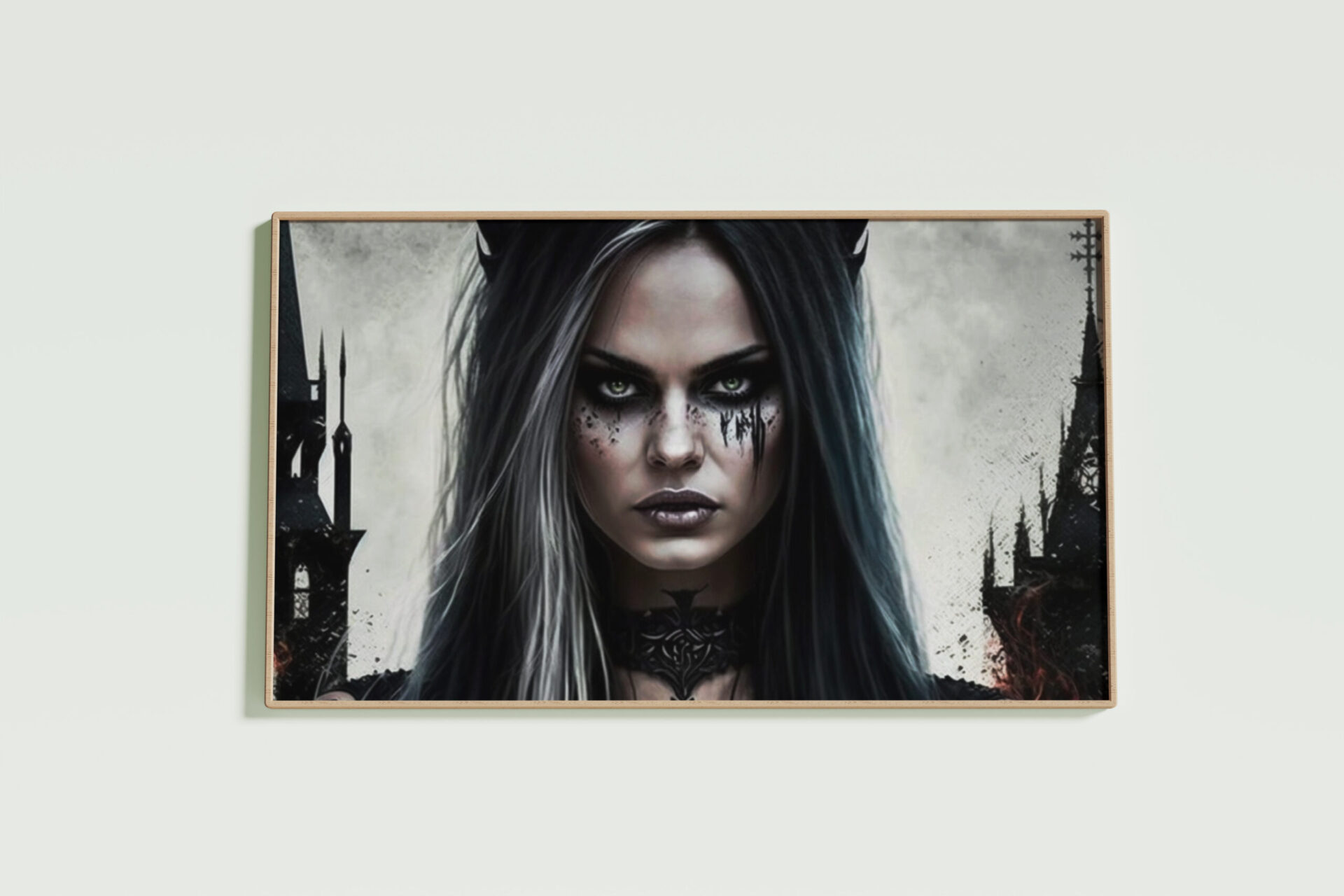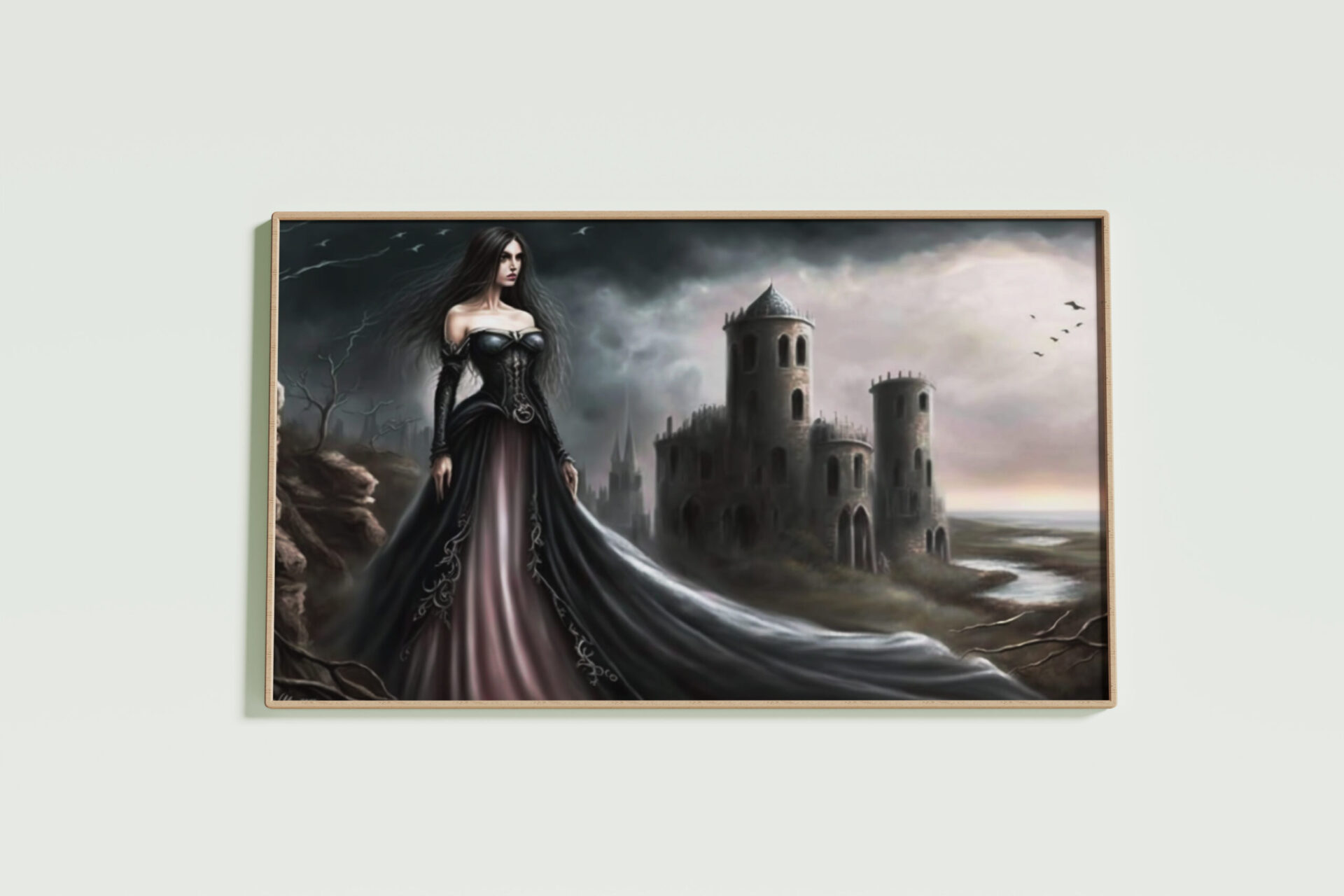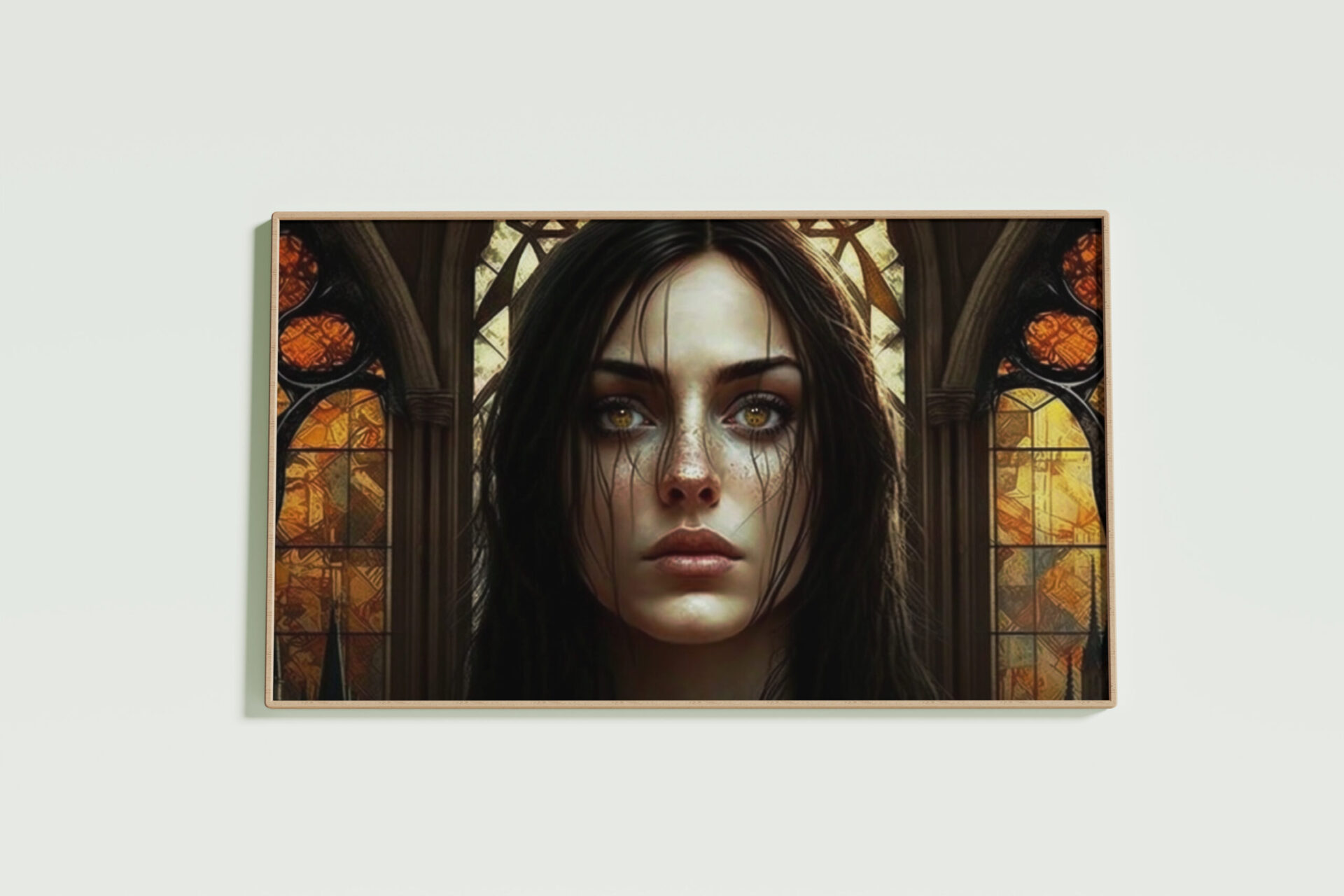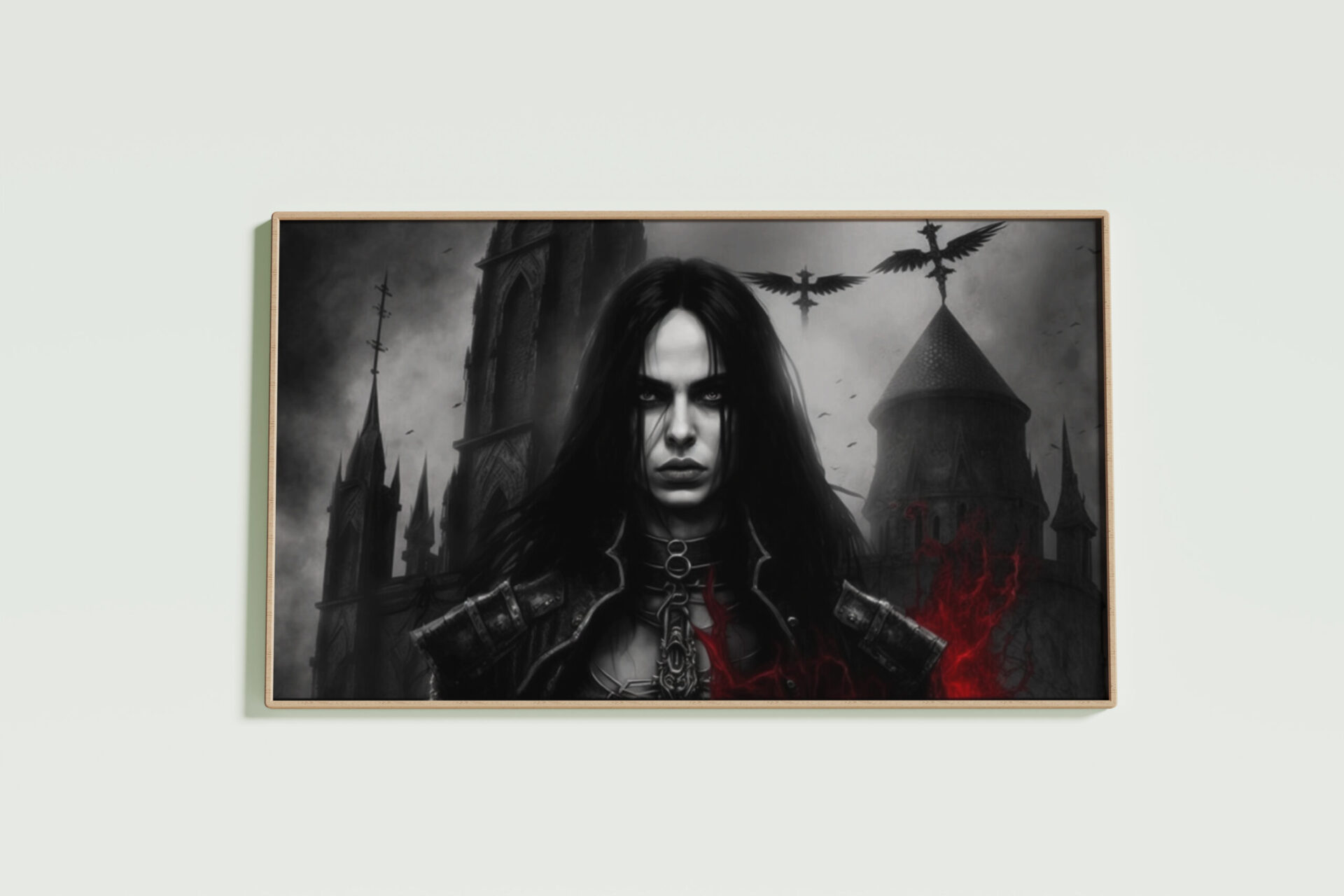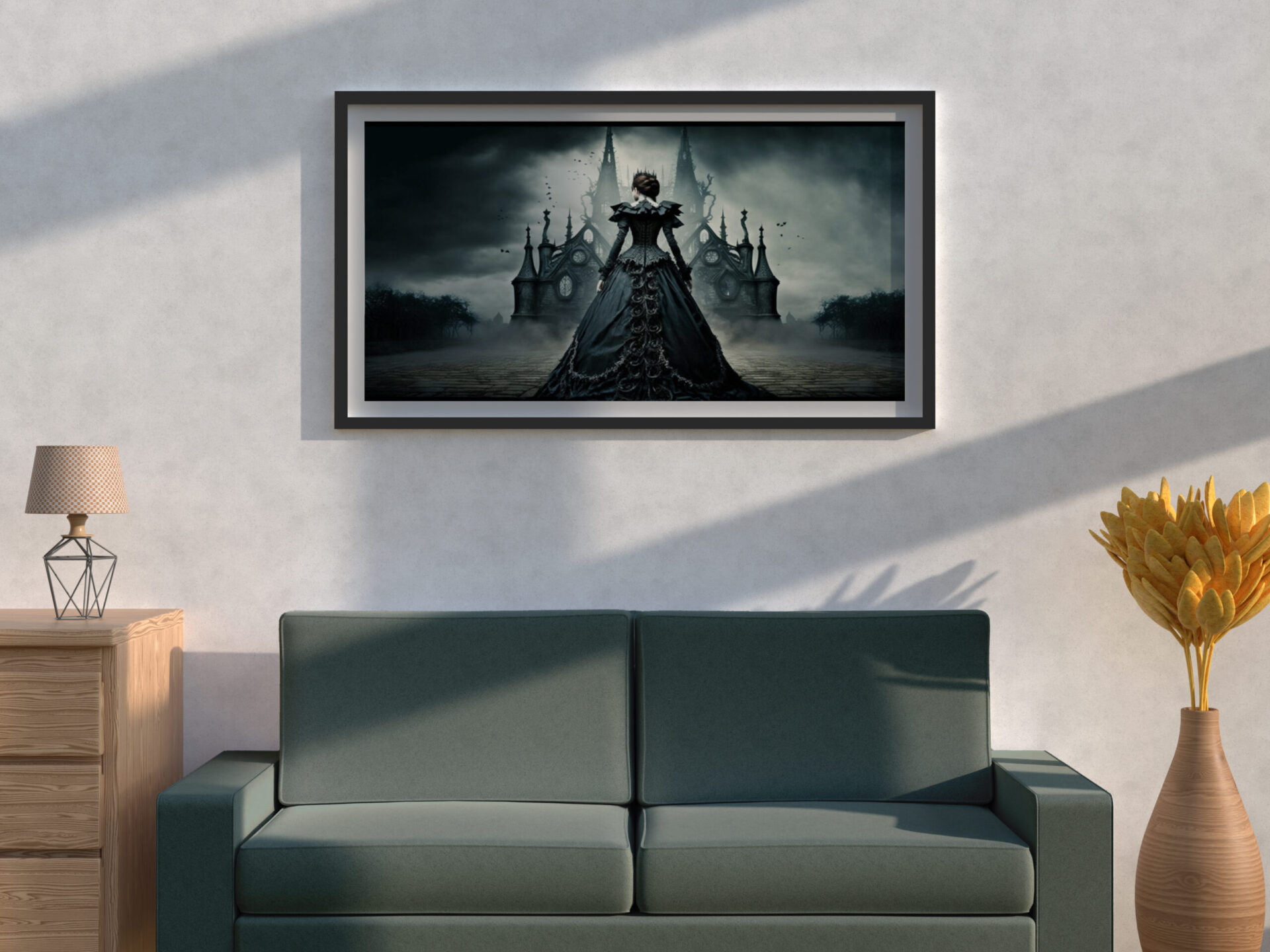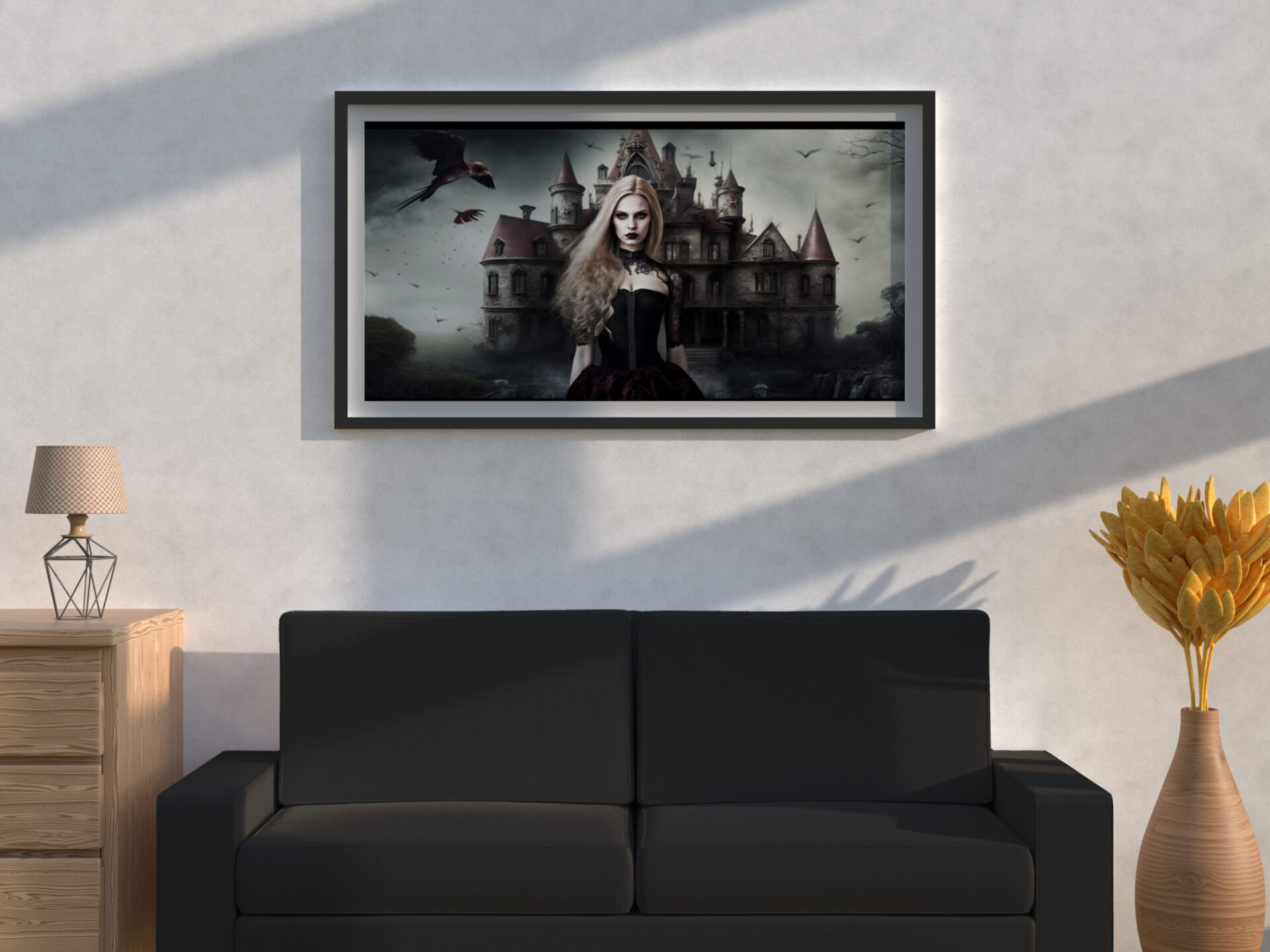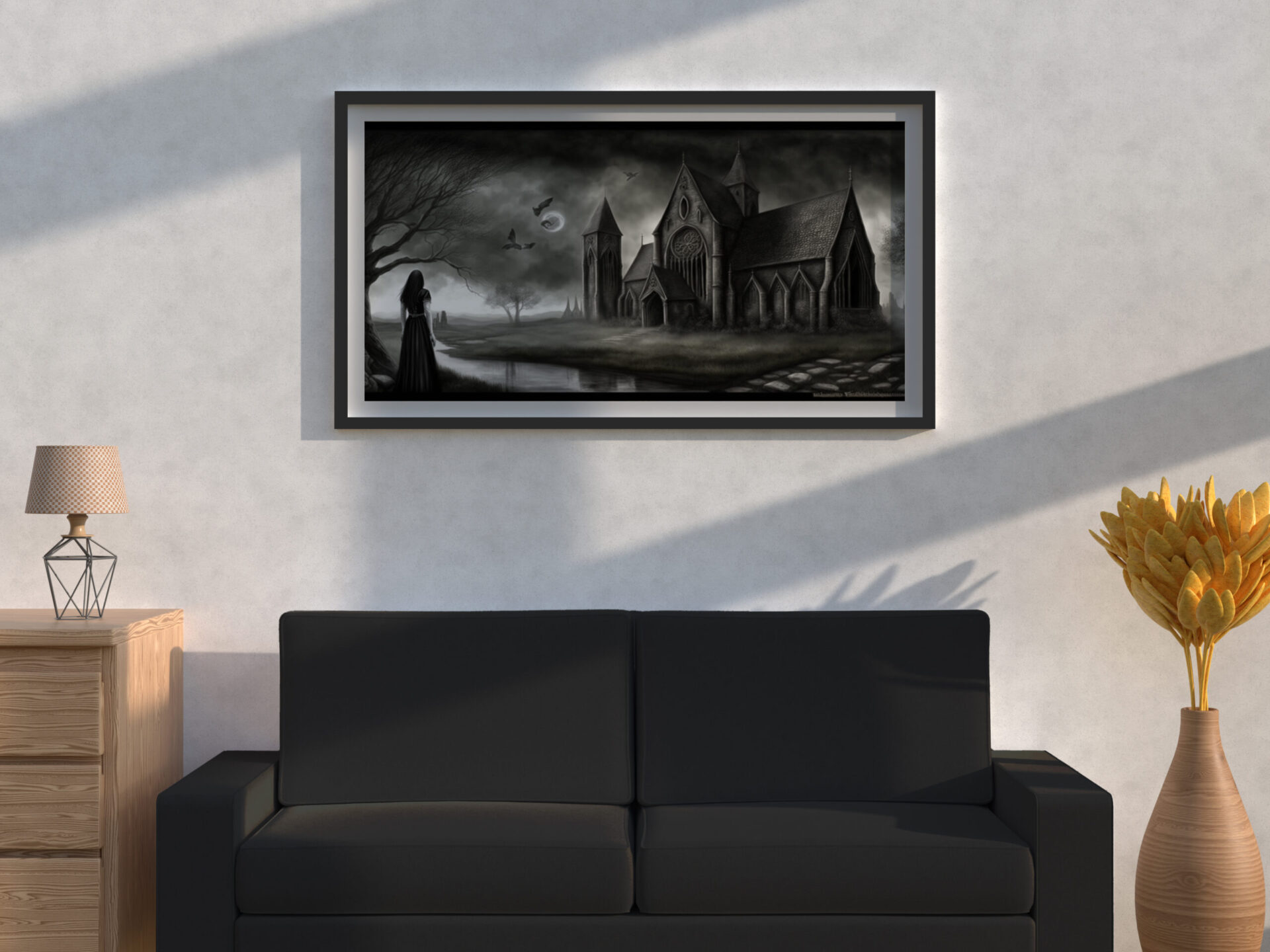Gothic wall art
Gothic Wall Art Girl
Gothic Wall Art Buffy
Gothic Wall Art Victorian
Gothic Wall Art Queen Raven
Gothic wall art Annabelle
Gothic wall art Angel
Gothic wall art Witchy Women
an exquisite selection of wall decor pieces that resonate with the dramatic and mysterious themes of the Gothic tradition. The collection ranges from framed wall art to canvas wall art, each piece meticulously crafted to bring the essence of Gothic aesthetics into your home.
Defining the Gothic Aesthetic in Wall Art

The Gothic aesthetic, a profound artistic movement, is marked by its emotive intensity and visual complexity. This section delves deep into the characteristics that make Gothic wall art so distinct and captivating.
Color Palette and Design Elements
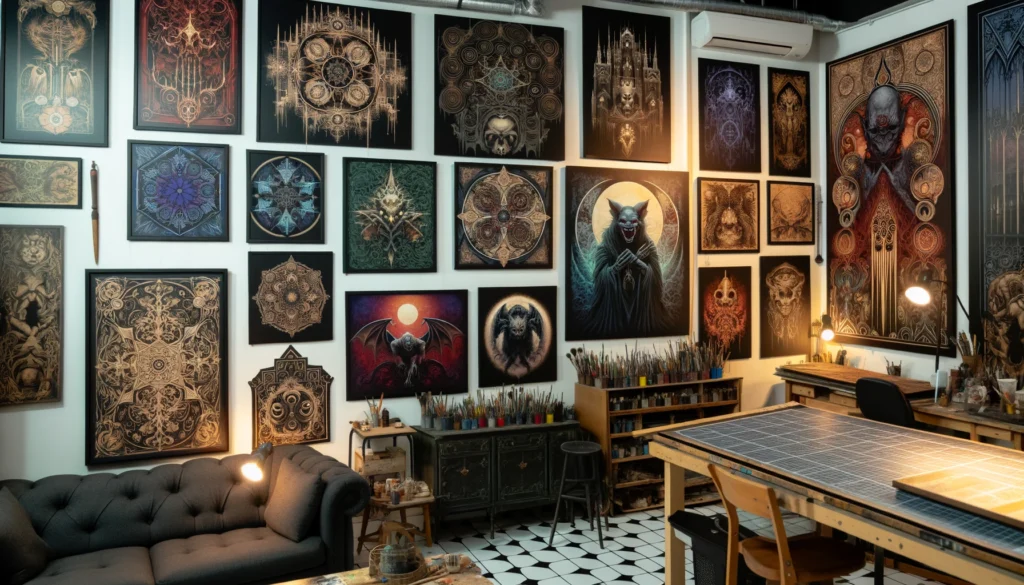
Gothic art often employs a dark yet rich color palette, dominated by shades of black, deep purples, and burgundy, interspersed with contrasts of gold and silver. This color scheme contributes to the dramatic and moody atmosphere characteristic of Gothic art.
In terms of design elements, the Gothic Wall Art Collection features:
- Intricate Patterns: Decorative motifs like spirals and geometric shapes.
- Floral and Botanical Designs: These often include thorny roses and winding vines, symbolizing beauty and mystery.
- Gargoyles and Mythical Creatures: Adding an element of the supernatural and folklore.
Symbolism in Gothic Art
Gothic art is rich in symbolism. Common themes include:
- Spirituality and Mysticism: Artworks often contain elements that represent a deep spiritual journey or connection to the mystical.
- Romanticism: A strong emphasis on emotion and individualism, often depicted through dramatic scenes or passionate imagery.
Architectural Influence
Gothic architecture heavily influences the art style, with artworks featuring:
- Pointed Arches and Ribbed Vaults: Representative of Gothic cathedrals and churches.
- Stained Glass Artistic Impressions: Mimicking the look of ancient stained glass windows.
Material and Texture
The collection includes a variety of materials, offering different textures and visual effects:
- Canvas Art: Ranging from smooth to heavily textured, depending on the technique used.
- Metal Wall Art: Providing a modern twist with materials like wrought iron or brushed steel, often used in sculptures or abstract pieces.
- Wood Wall Art: Adding a rustic, earthly feel to the Gothic aesthetic.
Incorporating Modern Elements
While rooted in historical themes, the Gothic Wall Art Collection doesn’t shy away from contemporary touches:
- Abstract Interpretations: Modern abstract forms juxtaposed with traditional Gothic elements.
- Fusion with Other Art Styles: Blending Gothic motifs with modern or other historical art styles to create unique pieces.
Framing and Presentation
The collection offers various framing options:
- Classic Framed Wall Art: Traditional frames that accentuate the Gothic feel.
- Gallery Wrap Canvases: Providing a modern, sleek look suitable for contemporary spaces.
- Triptych and Collage Layouts: Multi-panel arrangements that create a more expansive and immersive visual experience.
Gothic Architecture and Its Influence on Wall Art

Gothic architecture, renowned for its grandeur and intricacy, has profoundly influenced wall art. This section explores how architectural elements are intricately woven into the Gothic Wall Art Collection, making each piece a testament to the rich heritage of this style.
Key Architectural Elements
- Pointed Arches: These arches are a hallmark of Gothic architecture, symbolizing strength and elevation. In the wall art collection, these arches are often depicted in detailed prints or as central themes in abstract pieces.
- Ribbed Vaults: The complex rib patterns of Gothic ceilings are translated into art, adding a dimensional quality to canvas prints and metal wall sculptures.
- Flying Buttresses: Although challenging to incorporate into two-dimensional art, the essence of flying buttresses is captured through intricate line work and structural motifs.
The Role of Light and Shadow
- Chiaroscuro: This technique, using strong contrasts between light and dark, is often employed in Gothic wall art to mimic the dramatic lighting found in Gothic cathedrals.
- Stained Glass Effects: Many artworks in the collection mimic the luminous quality of stained glass, using vibrant colors and light effects to create a sense of awe.
Material Adaptations
- Stone and Marble Textures: Wall art that replicates the texture of materials commonly used in Gothic architecture, such as stone and marble, often in the form of high-quality prints or textured paintings.
- Metallic Finishes: Artworks featuring metallic accents or entirely made from metal, such as iron or bronze, pay homage to the ornate metalwork in Gothic design.
Gothic Sculptural Elements
- Gargoyles and Grotesques: These iconic sculptures are frequently represented, either in a realistic manner or stylized forms, adding a touch of Gothic mystery and folklore.
- Religious Iconography: Many pieces feature elements of Gothic religious sculptures, reflecting the spiritual undertones of the era.
Integration of Gothic Motifs
- Intricate Patterns and Carvings: Wallpaper and fabric wall hangings in the collection often feature patterns inspired by Gothic carvings and friezes.
- Architectural Blueprints and Sketches: Art pieces that include blueprints or sketches of famous Gothic buildings, offering a unique blend of art and architectural history.
Contemporary Interpretations
- Abstract Gothic Art: Modern artists take creative liberties, blending traditional Gothic architectural elements with contemporary art styles, resulting in unique and thought-provoking pieces.
- Digital Art and Mixed Media: Utilizing modern techniques to reinterpret Gothic architecture in a fresh and innovative way.
Symbolism and Themes in the Gothic Wall Art Collection
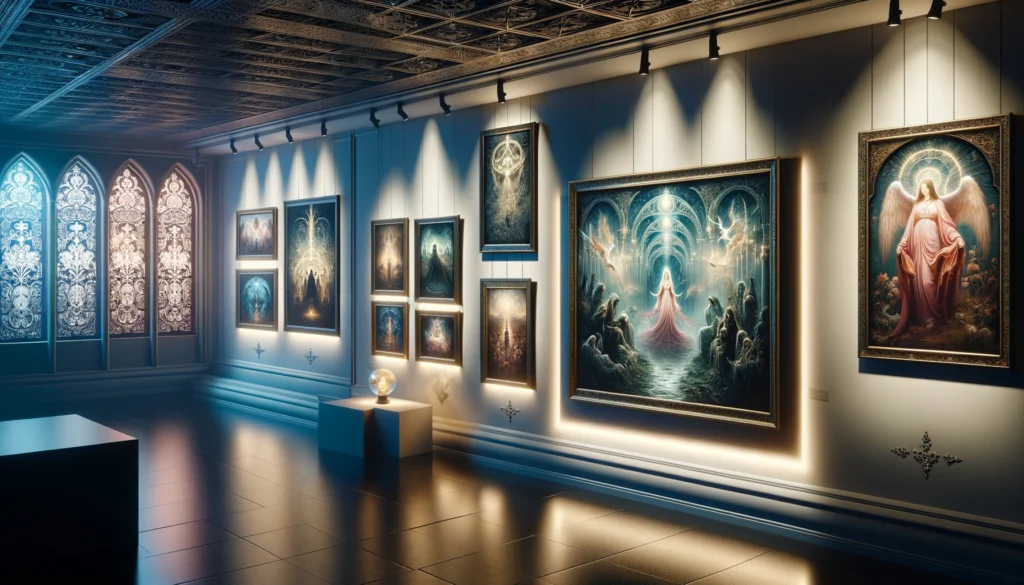
The Gothic Wall Art Collection is not just a visual feast; it’s a dive into a world rich with symbolism and thematic depth. This section uncovers the layers of meaning behind the collection’s pieces, exploring the symbolic narratives and themes that make Gothic art so captivating.
Exploring Gothic Symbolism
- Spiritual and Mystical Elements: Gothic art is known for its deep spiritual undertones. The collection features art depicting medieval religious scenes, angels, and other ethereal beings, offering a glimpse into the mystical aspects of the Gothic era.
- Romantic and Melancholic Themes: Gothic art often portrays themes of love, longing, and melancholy. This is evident in pieces featuring solitary figures, dramatic landscapes, or scenes of Gothic romance.
Nature and the Supernatural
- Floral and Botanical Motifs: Common in Gothic tapestries and stained glass, these motifs symbolize life, death, and rebirth. Floral canvas art and botanical prints in the collection often have a dark, enchanting quality.
- Gothic Creatures: Gargoyles, dragons, and mythical beasts are not just decorative; they symbolize protection, fear, or the unknown. These elements are vividly brought to life in sculptures and prints.
Gothic Narratives
- Historical Stories: Artworks often depict scenes from Gothic literature or historical events from the medieval period, telling stories through visual means.
- Allegorical Depictions: Many pieces in the collection use allegory to convey deeper meanings, such as the struggle between good and evil, life and death, or the natural vs. the supernatural.
Embracing the Macabre
- Skulls and Skeletons: These classic Gothic symbols, representing mortality and the ephemeral nature of life, are featured in various art forms within the collection.
- Dark Landscapes and Ruins: Paintings and prints often showcase dark, foreboding landscapes or ancient ruins, evoking feelings of nostalgia and the sublime.
Architectural Influence in Symbolism
- Cathedral Imagery: Many pieces feature cathedral windows, arches, or doorways, symbolizing gateways to another world or the divine.
- Sacred Geometry: The use of sacred geometric patterns in the art reflects the harmony and balance found in Gothic architecture.
Modern Interpretations of Gothic Themes
- Contemporary Gothic: The collection includes modern interpretations of Gothic themes, blending traditional motifs with current artistic trends and perspectives.
- Gothic Fusion: Artworks that fuse Gothic elements with other cultural or artistic styles, creating a unique blend that speaks to a wider audience.
Materials and Techniques in Creating Gothic Art
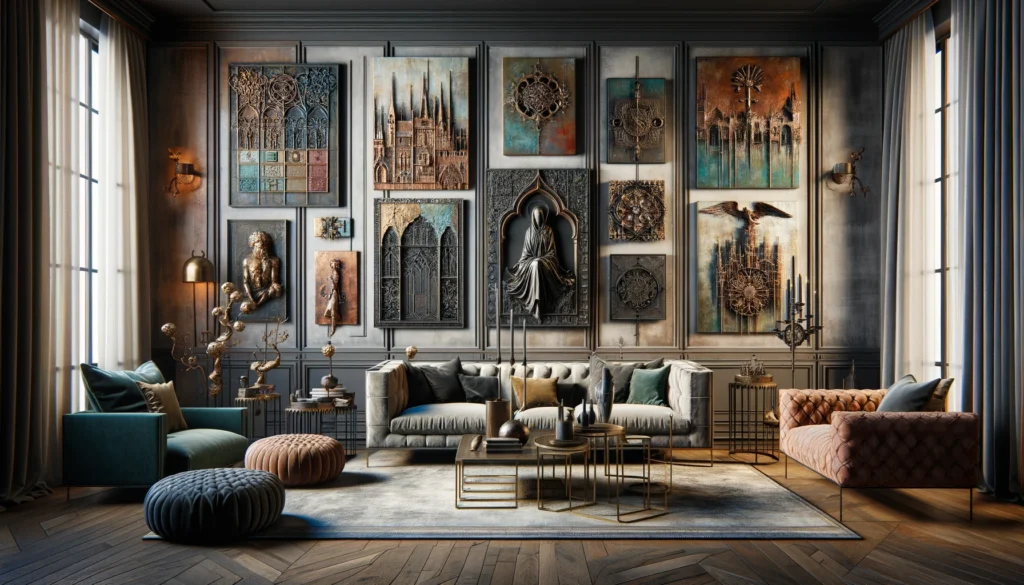
The Gothic Wall Art Collection is a testament to the diversity of materials and artistic techniques used to capture the essence of the Gothic style. This section delves into the various mediums and methods that bring these artworks to life, highlighting their unique qualities and how they contribute to the overall aesthetic of the collection.
Traditional Materials
- Canvas: A staple for paintings, canvas offers a versatile surface for a range of mediums, from oil to acrylic. In the collection, canvas art ranges from smooth, detailed renderings to heavily textured pieces that add depth and dimension.
- Wood: Used both as a canvas and a sculptural medium, wood in Gothic art often carries intricate carvings or is treated with special techniques to create an aged, rustic appearance, resonating with the medieval origins of the Gothic style.
Metal in Gothic Art
- Wrought Iron and Steel: Metal wall art in the collection often features Gothic motifs such as intricate scrollwork or architectural elements, crafted from metals like wrought iron or steel, adding a contemporary yet timeless feel to the pieces.
- Bronze Sculptures: Bronze, known for its durability and classic appeal, is used for creating statues and reliefs, often representing Gothic figures or scenes.
Modern Techniques and Innovations
- Digital Art: Some pieces in the collection are created using digital art techniques, allowing for the blending of traditional Gothic elements with modern design concepts, resulting in unique and contemporary pieces.
- Mixed Media: Combining various materials like fabric, metal, and paint, mixed media art in the collection offers a multi-dimensional experience, adding richness and complexity to the Gothic themes.
Textural Elements
- Relief Work: Raised elements in both metal and wood artworks create a tactile experience, bringing the Gothic motifs to life.
- Layering: Many canvas pieces employ layering techniques, where different materials or layers of paint are used to create a textured, dynamic surface.
Color Techniques
- Patina and Aging Effects: To mimic the ancient look characteristic of Gothic art, techniques like patina application or artificial aging are used, especially on metal and wood pieces.
- Vibrant Hues vs. Subdued Tones: While traditionally Gothic art is known for its darker palette, the collection also includes pieces with vibrant hues, creating a striking contrast and highlighting specific elements of the artwork.
Framing and Presentation
- Ornate Frames: Many framed artworks in the collection feature elaborate, Gothic-style frames, enhancing the artwork’s historical feel.
- Gallery Wraps and Floating Frames: For a modern touch, some canvas pieces are presented with gallery wraps or floating frames, offering a sleek, contemporary look suitable for modern interiors.
Integrating Gothic Wall Art in Modern Spaces
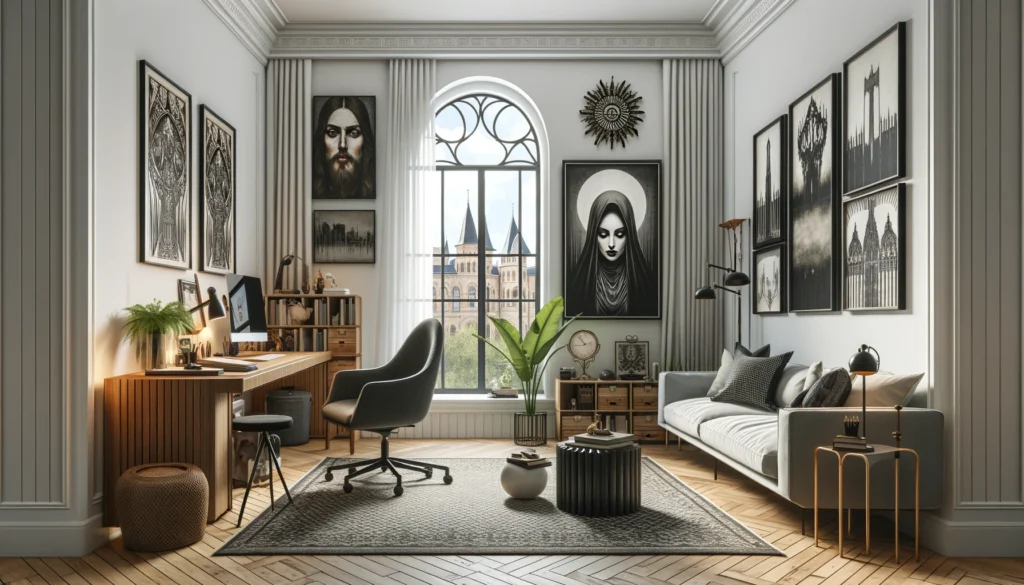
Introducing Gothic wall art into modern interiors is an art in itself. This section provides practical advice and creative ideas on how to incorporate pieces from the Gothic Wall Art Collection into various home settings, ensuring a harmonious blend that enhances both the art and the space.
Choosing the Right Piece for Your Space
- Size and Scale: Consider the size of the Gothic art piece relative to your room. Large wall art can be a focal point in spacious areas, while smaller pieces or a collage of framed art can accentuate more intimate spaces.
- Color Coordination: Match or contrast the colors in the art with your room’s palette. Darker Gothic pieces can create a striking contrast in a lightly colored room, and vice versa.
Thematic Integration
- Room Theme: Select Gothic art that complements the room’s existing theme. A floral Gothic canvas might suit a room with natural elements, while an abstract metal wall sculpture could enhance a more contemporary space.
- Mood Setting: Gothic art can set the mood of a room. A dramatic, dark piece can add depth and intrigue to a living space, while a lighter, romantic Gothic artwork can bring a sense of elegance to a bedroom.
Placement and Arrangement
- Focal Points: Use Gothic wall art as a focal point in a room, such as above a fireplace or in the main visual line of entry.
- Gallery Walls: Create a gallery wall with a mix of Gothic prints, framed art, and small sculptures. This can be an eclectic mix or a carefully curated collection following a specific theme or color scheme.
Complementing Decor
- Furniture and Fixtures: Pair Gothic wall art with furniture and fixtures that complement its style. For instance, a heavy wood frame might pair well with antique-style furniture, while a sleek metal piece might suit modern, minimalist decor.
- Lighting: Proper lighting can dramatically enhance the appearance of Gothic art. Consider directional lighting for large pieces or ambient lighting to create a mood around the artwork.
Creating a Cohesive Look
- Consistency in Style: While mixing different styles can be visually appealing, maintaining a level of consistency (like sticking to a particular Gothic sub-theme) can create a more cohesive look.
- Accessorizing: Complement your Gothic wall art with other decor elements like Gothic-style vases, candles, or throw pillows to tie the room together.
Avoiding Overcrowding
- Balance and Spacing: Be mindful of not overcrowding the space with too many pieces. Allow each piece of Gothic art to stand out and be appreciated on its own.
- Mixing Art Forms: Balance wall art with other art forms like sculptures or decorative plates, ensuring a varied yet harmonious aesthetic.
Spotlight on Notable Pieces in the Gothic Wall Art Collection
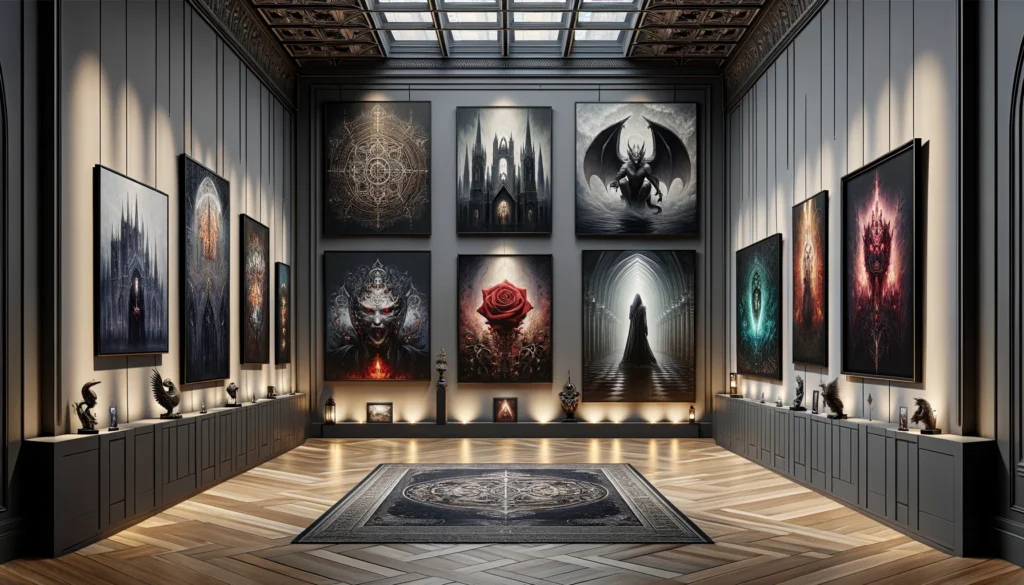
Highlights some of the most remarkable and captivating pieces within the Gothic Wall Art Collection, offering insights into their themes, artistic techniques, and the unique ways they can enrich a space.
Featured Artworks
- “Cathedral’s Whisper”: A large canvas piece showcasing the interior of a Gothic cathedral, with light streaming through stained glass. The use of chiaroscuro in this piece highlights the dramatic architectural details.
- “Gargoyle’s Gaze”: A metal wall sculpture featuring a detailed gargoyle. Its intricate craftsmanship brings a touch of medieval mystery to any room.
- “Midnight Rose”: This framed wall art, depicting a dark, blooming rose against a moonlit backdrop, combines botanical beauty with a moody, romantic Gothic feel.
Artist Spotlights
- Elena Moroz: Known for her detailed pen-and-ink drawings of Gothic cathedrals, Moroz’s works are a deep dive into the architectural majesty of the Gothic era.
- Richard Landon: A sculptor who brings Gothic gargoyles and mythical creatures to life in bronze and iron, adding a three-dimensional aspect to Gothic home decor.
Unique Techniques and Materials
- Hand-Painted Canvases: Several pieces in the collection are hand-painted, offering an authentic touch and unique nuances in each artwork.
- Digital Gothic Art: Incorporating modern digital techniques, these pieces reimagine traditional Gothic themes with a contemporary twist.
Thematic Variety
- Spiritual and Mythological Themes: Artworks like “Angel’s Descent” or “Dragons of the Old World” explore spiritual and mythical elements, perfect for adding a touch of mystique.
- Gothic Landscapes: Pieces such as “Mystic Forest” use dark, rich colors to portray enigmatic natural landscapes, imbued with a sense of Gothic wonder.
Integrating Art with Interior Design
- “Gothic Window”: A triptych that mimics the look of Gothic windows, ideal for adding architectural interest to a room.
- “Abstract Gothic”: This canvas wall art set features abstract interpretations of Gothic motifs, suitable for more modern or minimalist spaces.
Collector’s Corner
- Limited Edition Prints: The collection includes limited edition prints like “The Gothic Night”, offering exclusivity and a touch of luxury.
- Vintage Finds: Occasionally, the collection features vintage Gothic pieces, like a restored painting or a rare wall sculpture, appealing to collectors and enthusiasts.
Caring for Your Gothic Wall Art
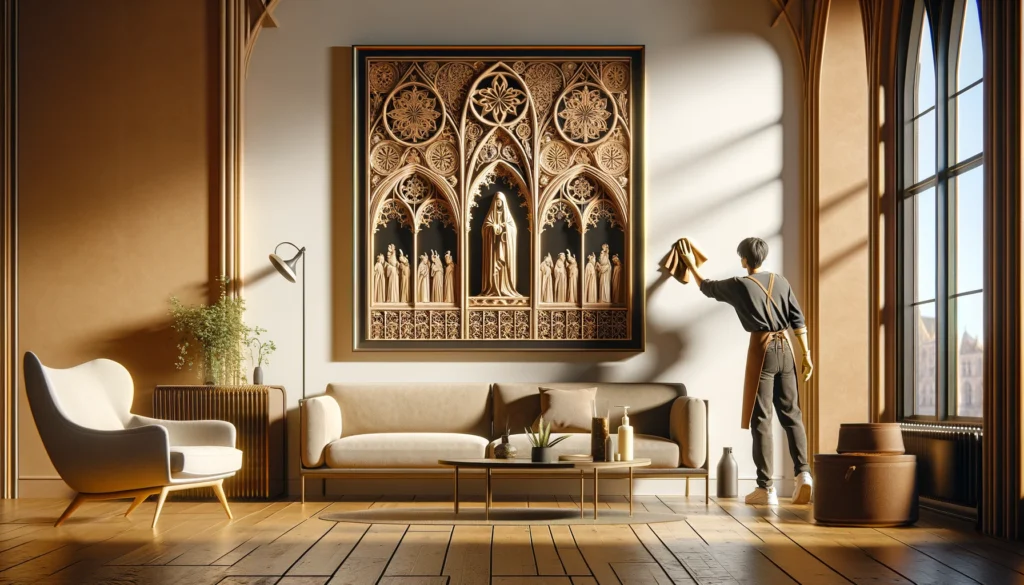
Maintaining the beauty and integrity of your Gothic wall art is essential for its longevity and continued impact in your space. This section provides detailed guidelines on how to care for and preserve various types of Gothic art pieces from the collection.
General Care Tips
- Regular Dusting: Use a soft, dry cloth or a duster to gently remove dust from the surface of the artwork. Avoid using harsh chemicals or abrasive materials.
- Avoid Direct Sunlight: Prolonged exposure to direct sunlight can fade the colors of your art. Position your pieces away from direct sun rays or use UV-protective glass for framed works.
Caring for Canvas Art
- Cleaning Canvas: Gently brush the canvas with a soft, dry brush to remove dust. If necessary, a slightly damp cloth can be used for spot cleaning, but avoid wetting the canvas.
- Canvas Stretching: Over time, canvas may become loose. Have it professionally re-stretched or tightened to maintain its shape.
Maintaining Metal Wall Art
- Rust Prevention: For iron or steel pieces, occasionally apply a clear protective coat to prevent rust. Keep metal art away from high humidity areas.
- Cleaning Metal Art: Wipe with a soft cloth. If needed, use mild soap and water, but dry thoroughly to avoid water spots or rust.
Wood Art Maintenance
- Wood Polishing: Use a wood-friendly polish to maintain the sheen. Do this sparingly to avoid buildup.
- Humidity Control: Extreme changes in humidity can cause wood to warp. Keep wood art in a stable environment.
Protecting Framed Art
- Glass Cleaning: For framed art behind glass, clean the glass with a non-ammonia glass cleaner and a soft cloth. Be careful not to let moisture seep into the frame.
- Frame Care: Dust frames regularly and check for signs of damage or wear. Repair or replace damaged frames to protect the artwork.
Handling and Transportation
- Safe Handling: Always handle art with clean, dry hands or wear cotton gloves. When moving art, support the frame or the edges, not the surface.
- Transporting Art: When moving or storing, wrap art in soft, non-abrasive materials and ensure it’s securely packed to prevent damage.
Long-Term Preservation
- Professional Advice: For valuable or antique pieces, consult with a professional conservator for specific care instructions or restoration needs.
- Regular Inspections: Periodically inspect your art for any signs of deterioration, such as fading, cracking, or mold, and address any issues promptly.
Embracing the Timeless Elegance of Gothic Art

In conclusion, the Gothic Wall Art Collection offers a unique opportunity to bring a piece of artistic history into your living space. This collection is not just about decorating your walls; it’s about embracing a style that has stood the test of time, bringing with it a sense of mystery, depth, and sophistication.
The Timeless Appeal of Gothic Art
- Historical Significance: Gothic art draws from a rich historical tapestry, embodying centuries of cultural and artistic evolution. Its enduring popularity speaks to its ability to evoke emotion and provoke thought.
- Aesthetic Versatility: Whether in a traditional or contemporary setting, Gothic art has a chameleon-like ability to adapt and enhance different interior styles, from the minimalist to the ornate.
The Gothic Wall Art Collection: More Than Just Decor
- Diverse Range: From hauntingly beautiful canvas prints to intricate metal sculptures, this collection offers a wide range of artworks that cater to varied tastes and decor styles.
- Symbolic Depth: Each piece in the collection is imbued with symbolism and meaning, inviting viewers to delve deeper into the artwork and perhaps discover something new about themselves.
Transforming Spaces with Gothic Art
- Mood Enhancement: Gothic art pieces can significantly alter the mood of a room, adding an element of drama, elegance, or mystery, depending on the chosen artwork.
- Personal Expression: Selecting Gothic art for your home is also a form of personal expression, a way to showcase your individual tastes and aesthetic preferences.
An Invitation to Explore
- Continued Discovery: The Gothic Wall Art Collection is continually evolving, with new pieces and artists being added, offering an ongoing opportunity for discovery and enjoyment.
- Encouraging Creativity: The collection not only adorns your space but also inspires your own creativity, whether in interior design or in appreciating the broader world of art.
Final Thoughts
The Gothic Wall Art Collection represents more than just wall decorations; it’s a gateway to a world of deep emotions, rich history, and artistic mastery. It invites you to explore the darker, more introspective aspects of art and beauty, enriching your home and life with stories and images that have captivated human imagination for centuries.
By integrating pieces from this collection into your home, you’re not just hanging art; you’re creating an environment that reflects a profound narrative, one that continues to inspire and fascinate. The Gothic Wall Art Collection is an invitation to bring a piece of timeless elegance into your everyday life.






